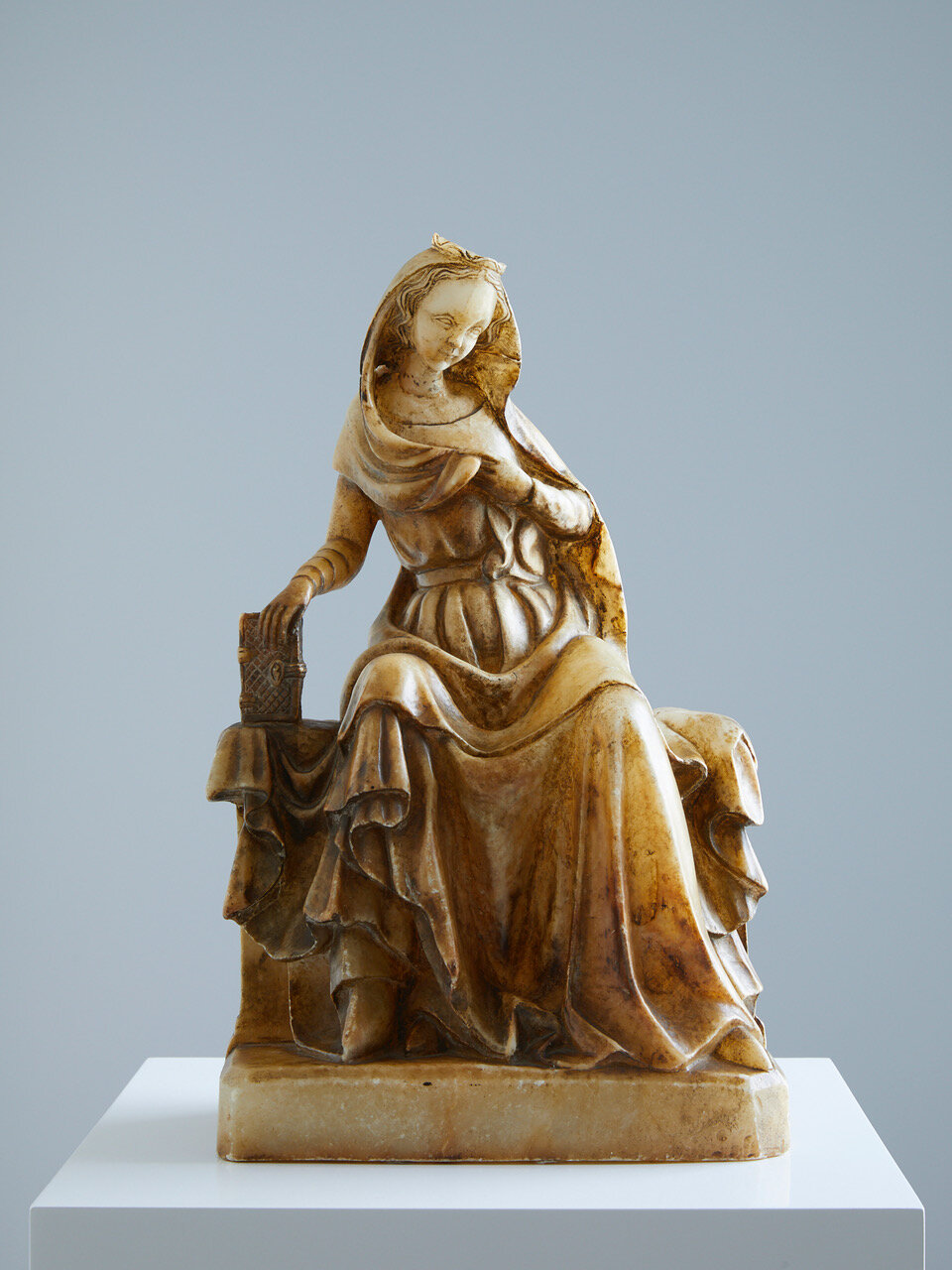
The Virgin of the Annunciation
15th century, Bohemia (Czech Republic)
430 x 260 x 150mm
Provenance: Private collection, Madrid, Spain.
A very fine carved alabaster statue of The Virgin of the Annunciation, surprised in her spiritual meditations by the apparition of the archangel Gabriel, announcing her conception of the Christ child. This statuette’s sensitively carved features and slight smile, elongated proportions, and graceful draperies show stylistic analogies to courtly art in Paris. In fact, this is a very direct copy of the early 14th century French limestone Virgin of the Annunciation (1300 - 1310, 424 x 296 x 188mm) now housed in the Metropolitan Museum of Art, New York.
A comparable piece was catalogued by the French Haute Epoque expert and art consultant, Laurence Fligny. Fligny designates the piece as Central European, Bohemian or Pomeranean, c. 1420/1430. Both of these pieces would appear to belong to the same period of artistic creativity in early 15th century Bohemia.
King Charles IV of Bohemia (c.1316 - 1378) was determined to rebuild his capital city Prague in the image of Paris and Rome, and to turn it into a hub of learning, spirituality, and the arts. A new generation of Bohemian artists drew specifically on international prototypes (such as the Paris Virgin) to embellish Charles’ building projects. This artistic activity continued well after Charles’ death in 1378. Amongst the many iconic religious images produced around 1400 were a series of paintings and sculptures of ‘Miraculous Madonna’s’, many of whom inspired intense cult followings. These images expressed a distinct aesthetic, known as ‘The Beautiful Style’, which depicted Mary as a courtly medieval princess. These so-called ‘Beautiful Madonna’s’ are characterised by an affected elegance; typically, cascading folds of drapery cover a demure female figure poised in an exaggerated ‘S’ stance. The facial features are similarly distinctive; a girlish face with a high smooth forehead, delicate chin and lips, and almond eyes. The necks are elongated and curved, the shoulders narrow, and the fingers of the hands long and tapering. All of these features are very evident in this sculpture, dating it to the early 1400s. Early alabaster figures almost always show traces of polychromy and/or gilding — or glazing intended to make them resemble bronze, since the most admired and technically impressive statues from antiquity were cast in this material. The patination on this piece is suggestive of this kind of ‘bronze’ glazing.
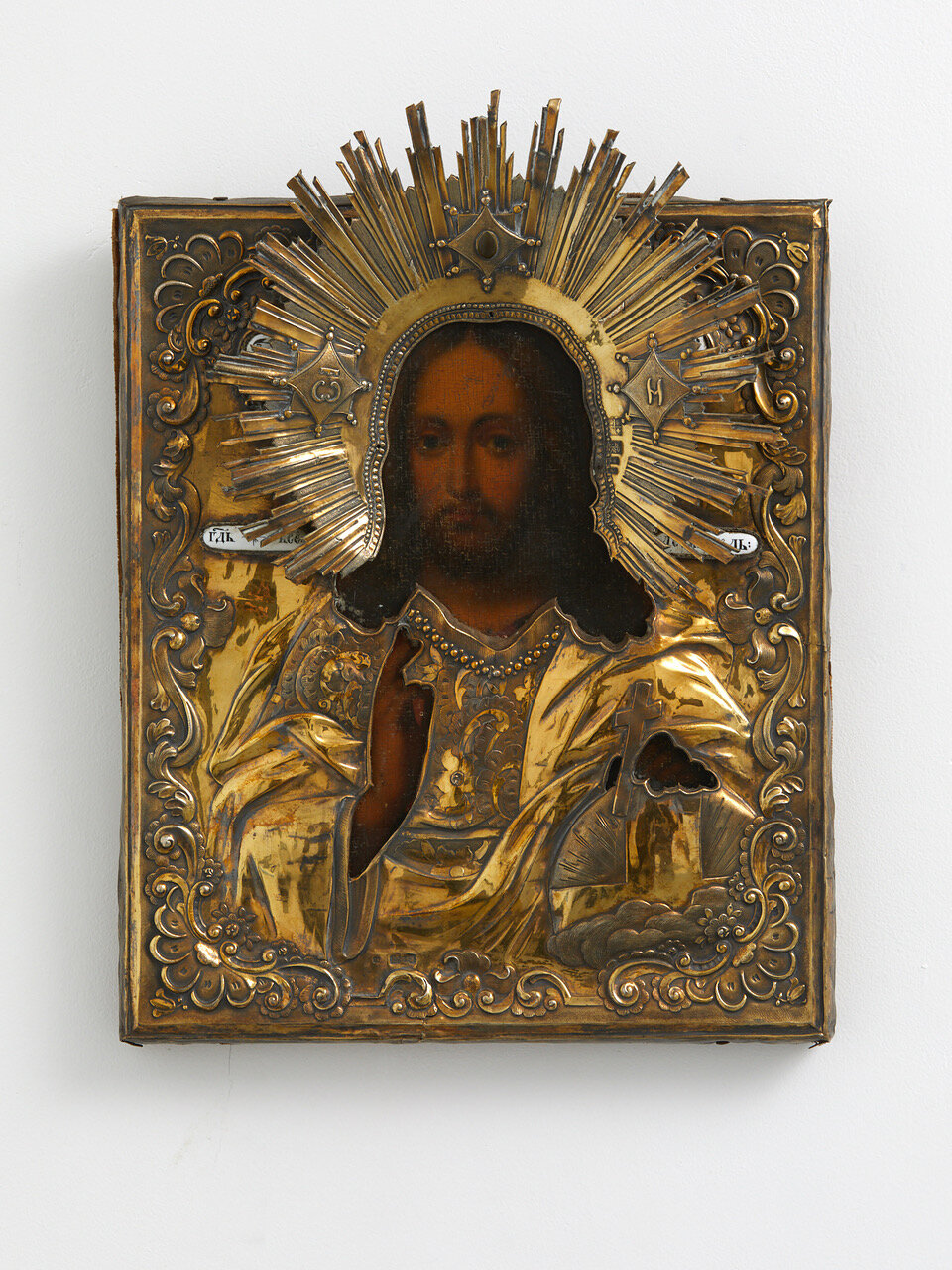
Orthodox Icon of Christ the Pantocrator
Mid-late 18th century, Western Russian (probably St Petersburg)
350 x 265 x 65mm
Provenance: Private family collection of a Russian emigre, Rhode Island, USA.
An Orthodox icon painted in oil on a wooden panel and covered with a heavy, carved, repoussé silver covering (called an oklad). The subject is Christ as the Pantocrator, or teacher of men. This is very common theme in Orthodox iconography, but this particular icon shows Christ in a more sophisticated three-quarter view, as opposed to a frontal view which is the more typical presentation. Traditionally icons were painted in egg tempera and the figuration was highly stylised, but in the mid 18th century the influence of Western portrait painting produced a new type of icon, painted in oils and offering more naturalistic and humanised images. The silver coverings or oklads were commissioned by families for icons which had proven effective in focusing prayers and producing results. In this way the icon was protected (from dirt and smoke from incense and icon lamps) and also honoured.
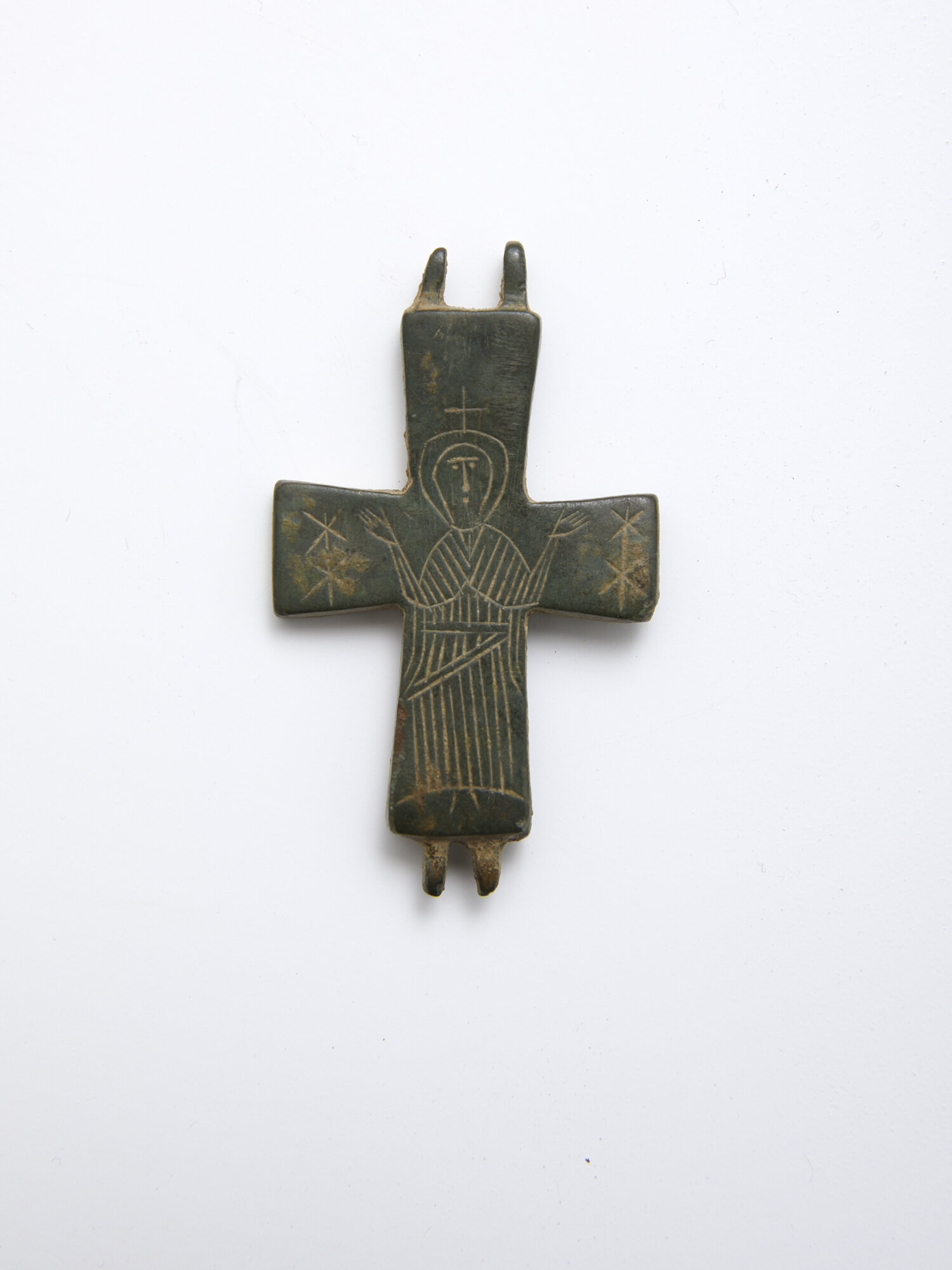
Bronze Enkolpion
Middle Byzantine Period, 10th - 12th century AD, Byzantium (Eastern Roman Empire)
60 x 40 x 5mm
Provenance: Private collection, Munich, Germany.
Half of a bronze enkolpion (medallion) with engraved figure standing in the attitude of Orans (a posture of prayer and supplication) and wearing a long robe, with nimbus and cross, and two stars flanking each hand of the figure. Green patina, minor damages at the hinges. These cruciform reliquaries were worn around the neck and many were produced in such a way as to hold a secondary relic (such as a piece of a saint’s clothing or hair, or a piece of the True Cross). They are believed to have substituted the use of bullae (pendants containing amulets against incantations), which were worn by Romans prior to Christian conversion. In this way, it can be regarded as an object, which bridges the Graeco-Roman and Christian worlds presented in Provenance II.
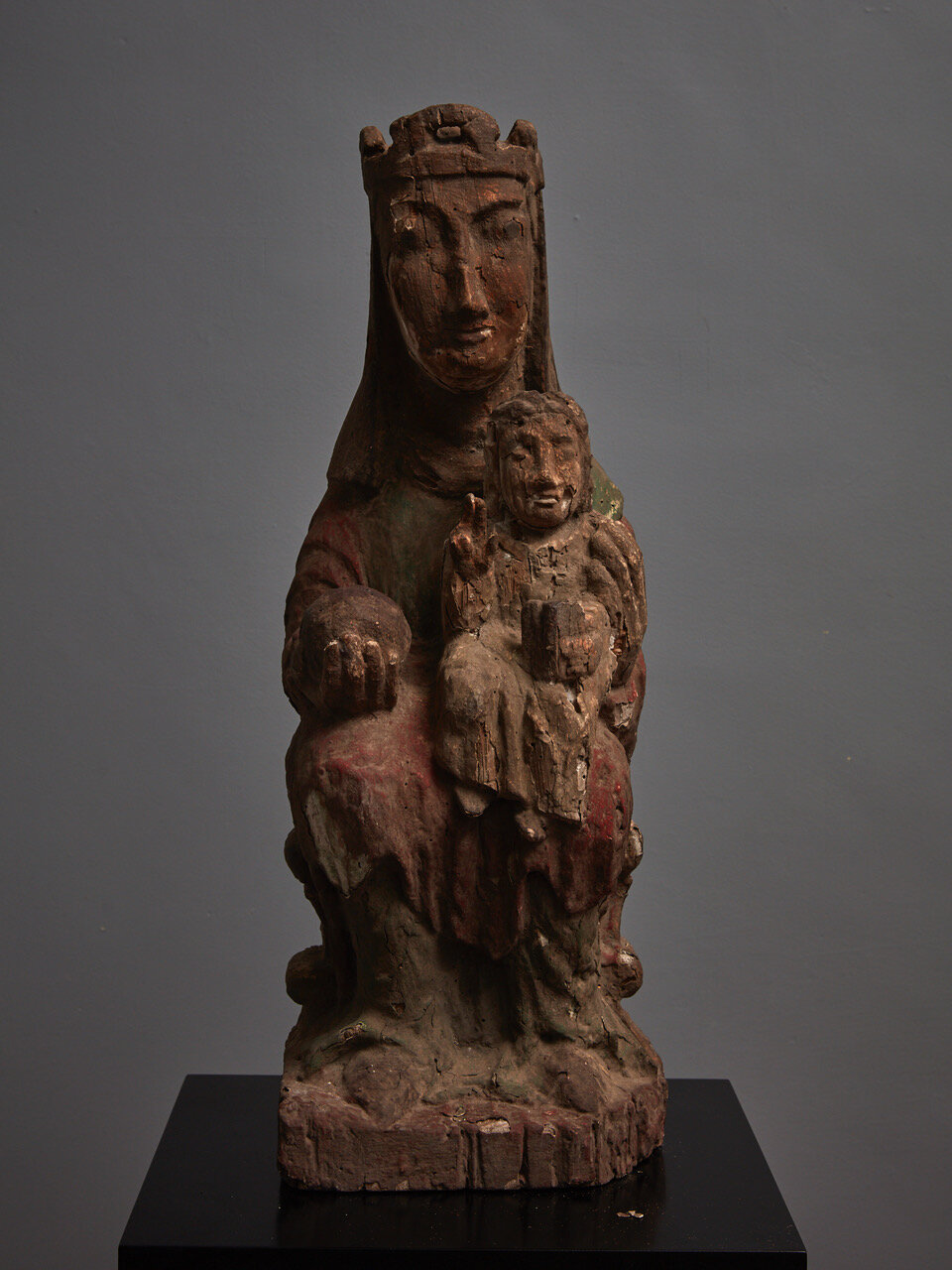
Madonna and Child (Sedes Sapientiae)
12th - early 13th century, Northern Europe (probably Spain)
580 x 210 x 170mm
Provenance: Private collection, Spain.
A softwood Madonna and Child statue, heavily distressed but essentially intact, with traces of polychromy (probably egg tempera). Both figures are rendered in the typical Romanesque style; the composition is formal and frontal, with the Christ child sitting on the Madonna’s left knee. She holds a pomegranate with her right hand, symbolic of the blood and resurrection of Christ, and the Christ’s right arm is raised, his hand making the gesture of benediction (blessing). The Madonna’s face is massive and mask-like, as is that of the Christ, emphasising that they are eternal presences rather than ordinary human beings. As in Byzantine iconography — from which the Romanesque style is derived — the primitive, highly stylised rendering of the Madonna and Child serve to accentuate their sheer spiritual power.
The figure of the Virgin and Child enthroned was a hugely popular iconographical theme particularly during the Middle-Ages. Throughout the 12th century, the Virgin Mary appears in churches all over Europe (France, Germany, Belgium, Scandanavia, England, Italy and Northern Spain) sitting majestically, her body forming Christ’s throne. This kind of presentation is called Sedes Sapientiae, meaning The Throne of Wisdom.
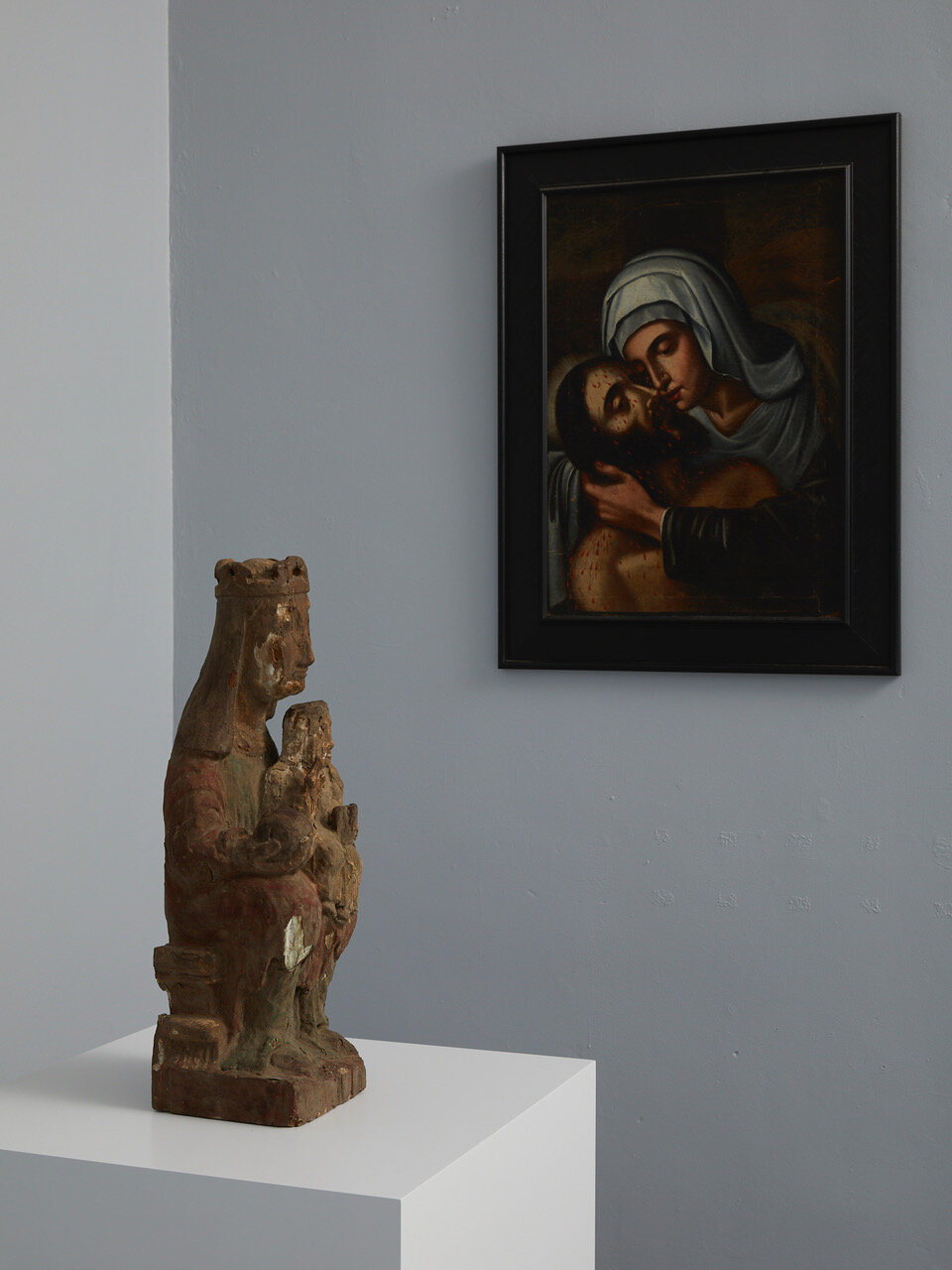
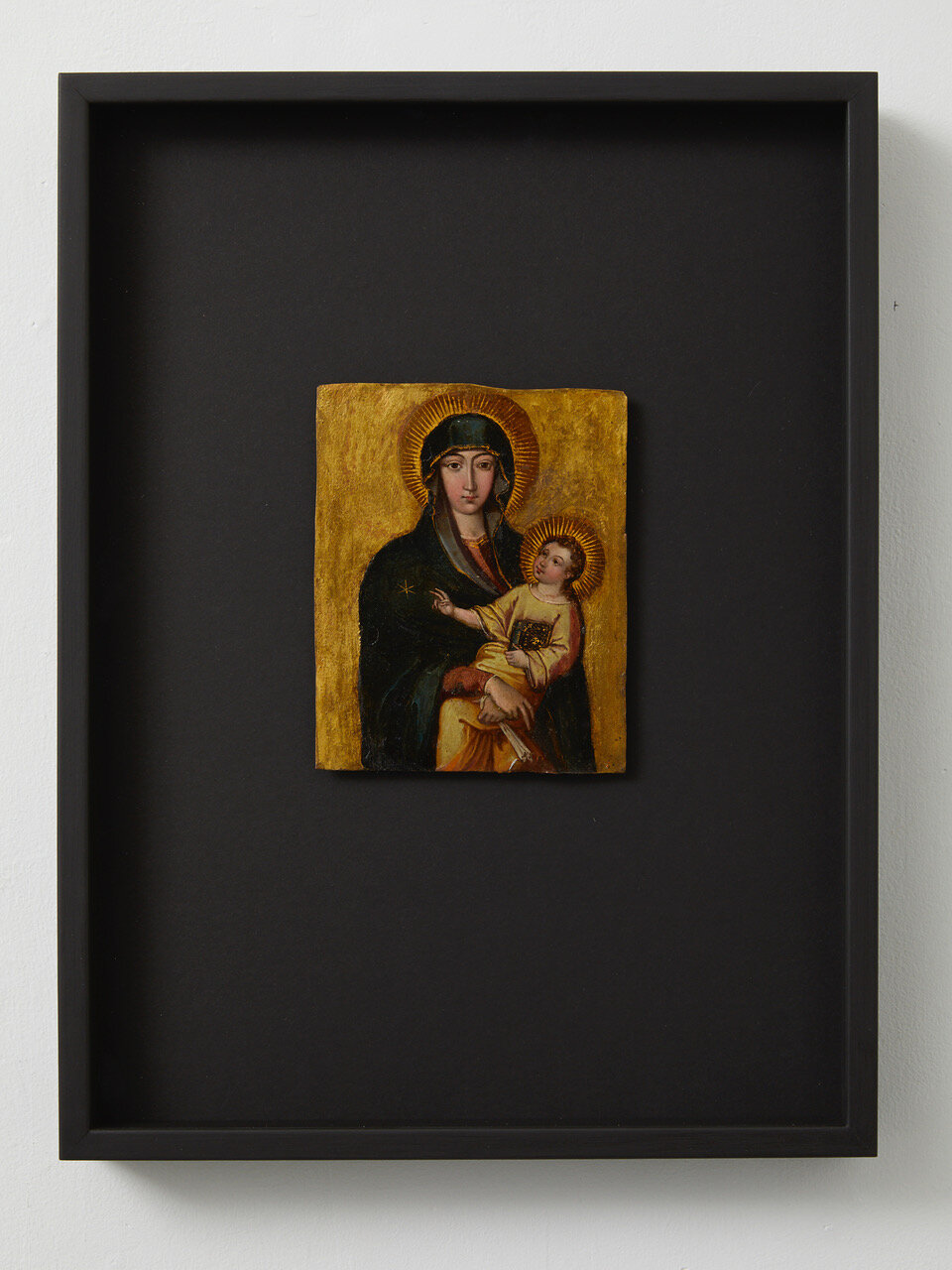
Virgin del Populo
18th century, Continental Europe (most likely Southern Spain or Italy)
160 x 130mm
Provenance: Private collection, Madrid, Spain.
Catholic icon of the Virgin Mary holding the Christ Child, painted in oils on a heavy gauge copper sheet, with a thick application of gilding in the background. The young Jesus is making a gesture of benediction (blessing). This is one of many copies made of an original icon supposedly painted by Saint Luke (who, according to Catholic tradition, was the first icon painter). St Luke’s original version is reputed to have miraculously ended a plague epidemic in Rome in 1231, and thereafter was known as the Sales Populi Romani (The Salvation of the Roman People). The Virgin del Populo became one of the most popular Marian icons through the centuries, attracting many pilgrims to the church of Santa Maria del Populo in Rome, where it is still housed today.
Copies of both Catholic and Orthodox icons — even the smallest and crudest — are felt by the faithful to share something of the miraculous qualities of the original. Hence there was a proliferation of large and small copies of The Virgin del Populo throughout the Catholic world, stretching as far as Eastern and Northern Europe, and the New World. The Virgin del Populo was specially venerated in Italy and Southern Spain, particularly Seville and Cadiz. The sheer popularity of this image makes it hard to determine the origin of this particular version: however, given its provenance, it is most likely to be Spanish.
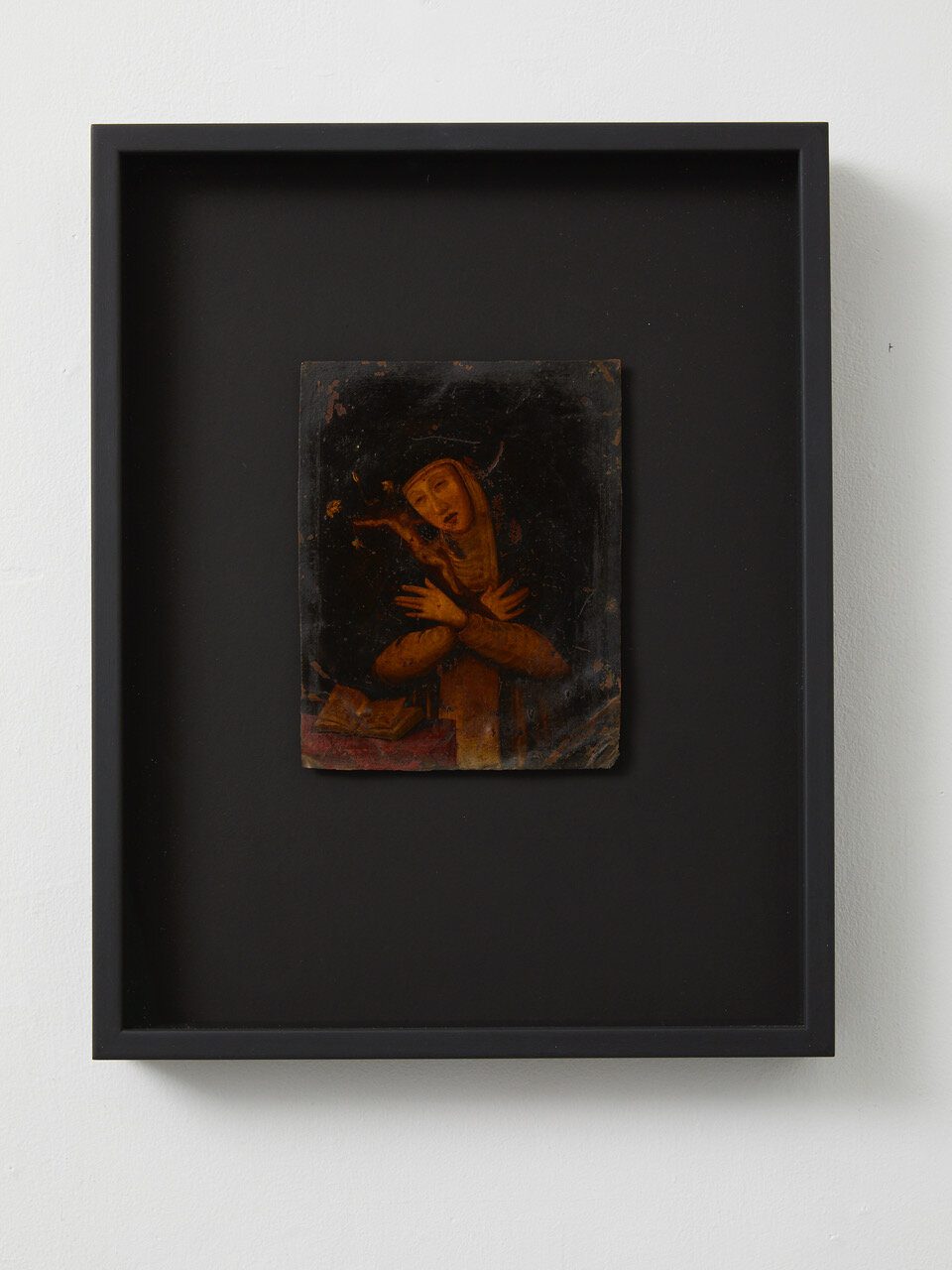
Saint Catherine of Siena in Meditation
12th - early 13th century, Northern Europe (probably Spain)
180 x 140mm
Provenance: Private collection, Madrid, Spain
Catholic icon painted in oils on copper sheet. It depicts the saint Catherine deep in meditation, wearing her characteristic Dominican robes. She holds her usual attributes, a stem of lilies and a crucifix, and is shown before an altar or table upon which a bible lies open. Saint Catherine of Siena was a Dominican tertiary and mystic who lived in Italy in the 1300s. She was known for her holiness, asceticism, and spiritual visions, and was said to have received stigmata. She was also a reformer and political activist, and was influential in both the religious and political affairs of the church. Her image was popular as the subject of small paintings like this, intended for use in the homes of the Catholic faithful.
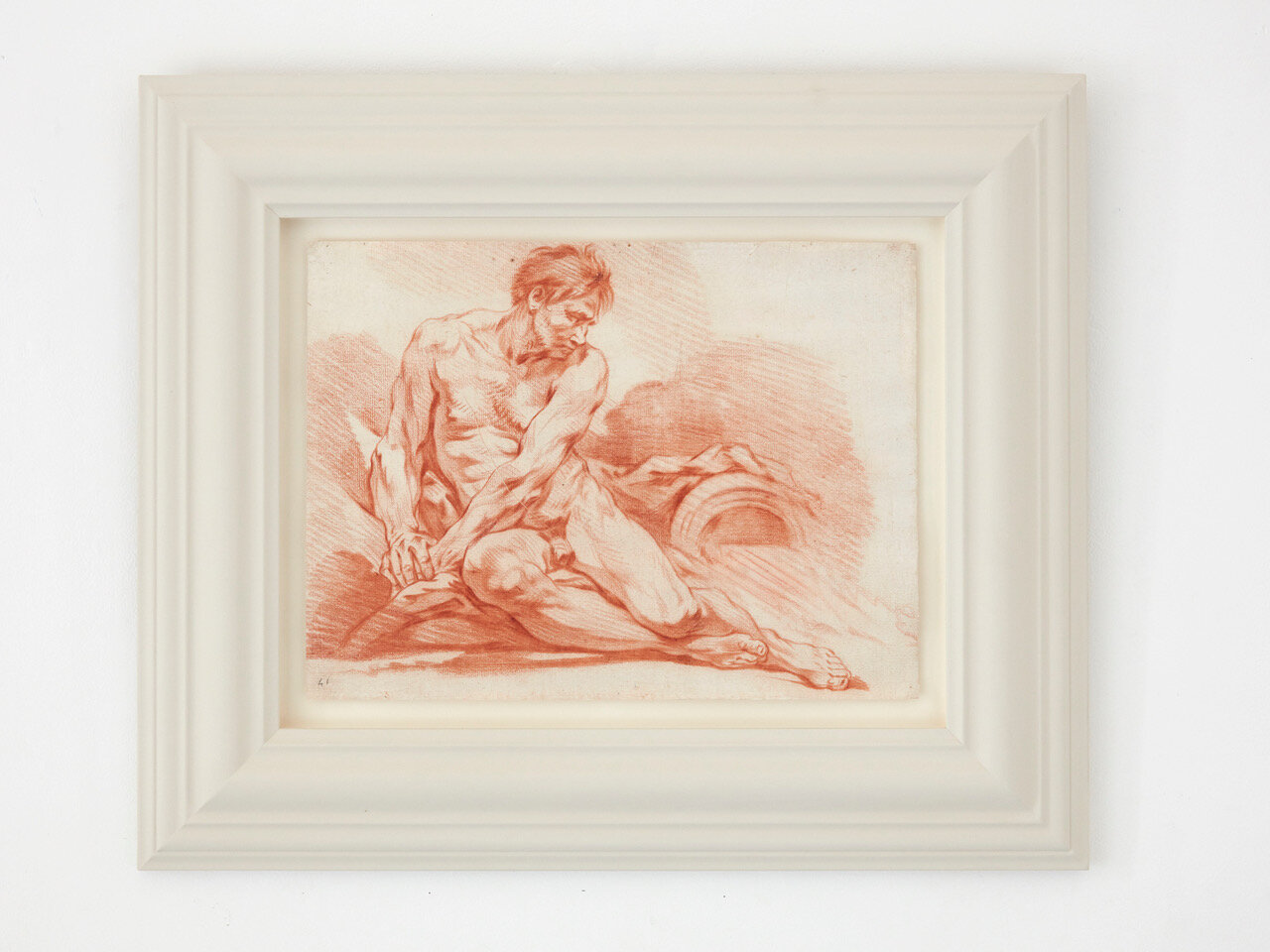
Drawing by François Boucher
1703-1770, Paris
275 x 370mm
Provenance: Private collection, Spain.
An academic drawing in sanguine chalk depicting a male nude. François Boucher (c. 1703–1770) was a French Rococo painter, engraver, and designer, who epitomised the frivolity, elegance, and extravagance of the French court in the 18th century. His career was hugely successful and he received many honours, becoming Director of the Gobelins factory in 1755 and Director of the Academy and King's Painter in 1765. He was the favourite artist of Louis XV’s most famous mistress, Madame de Pompadour, to whom he gave lessons, and whose portrait he painted several times.
Boucher was also a virtuoso draftsman. Drawings played a large role in the preparation of paintings and as designs for printmakers, as well as being created as finished works of art for the growing market of collectors. For his major canvases, Boucher followed standard studio practices of the time, working out the overall composition and then making chalk studies for individual figures or groups of figures. He was an incredibly productive artist, making thousands of drawings both as sketches and finished works in chalk, ink, and pastels. One of the most notable things about Boucher's superb draughtsmanship is his energetic, economical mark-making. Grace, beauty and power combine with a striking inner force. Such was his popularity that a great number of printmakers found it lucrative to reproduce his paintings and drawings; some 1,500 prints after Boucher are known today.
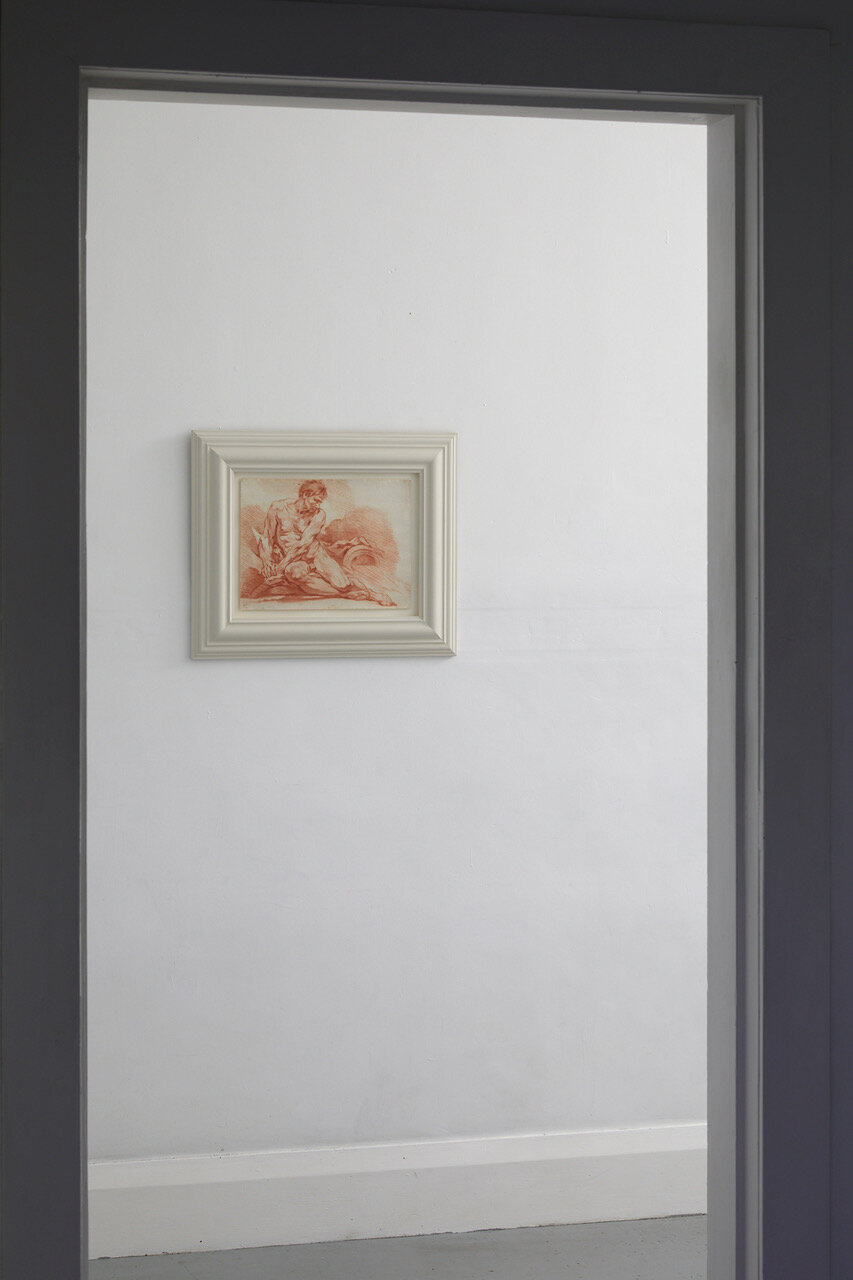
Drawing by François Boucher
1703-1770, Paris
275 x 370mm
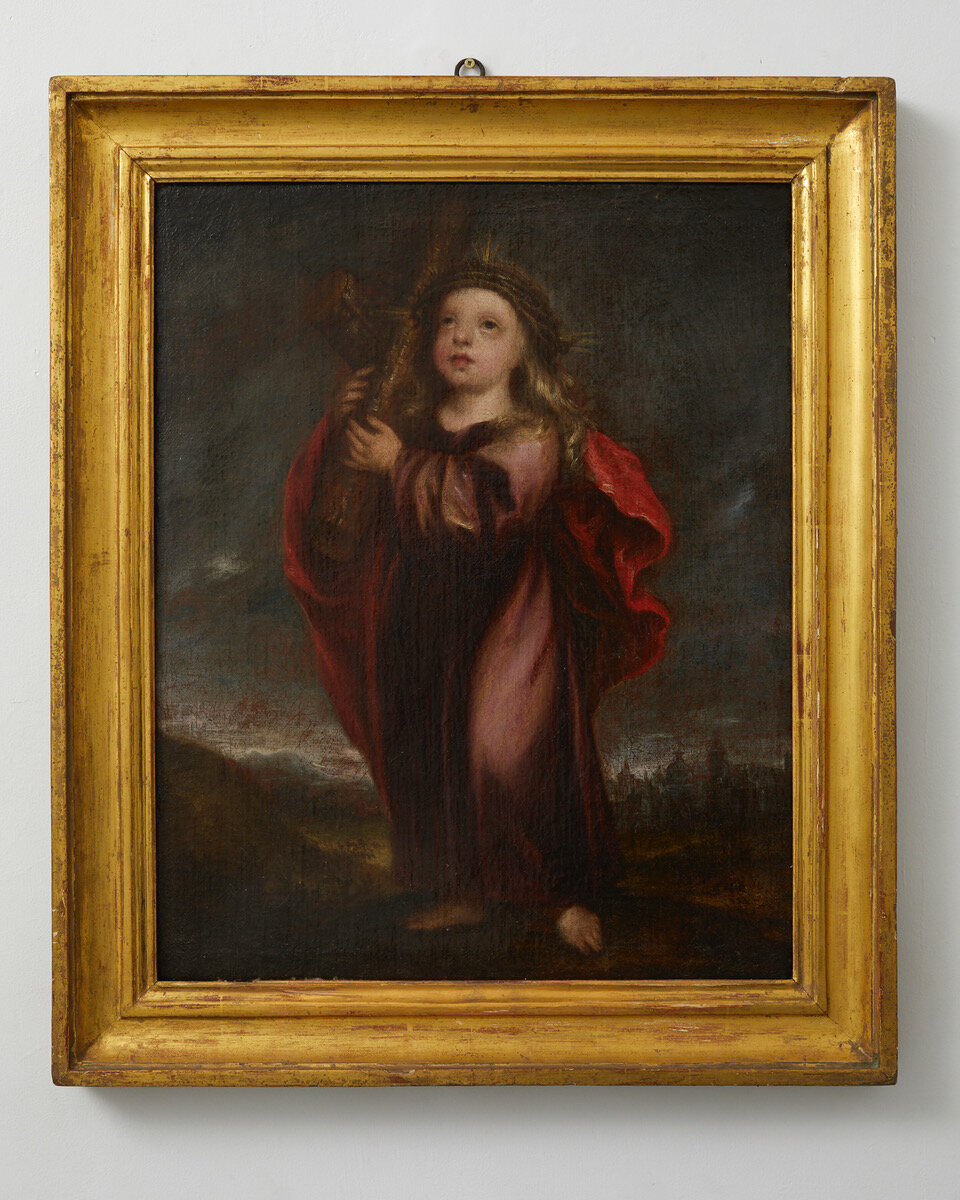
Christ Child with Instruments of the Passion
17th - 18th century, Iberian Peninsula School
620 x 495mm
Provenance: Private collection, Madrid, Spain.
Oil on canvas depicting the young Christ child walking alone in a darkening landscape, wearing a red robe and a crown of thorns, and carrying a wooden cross. He looks upwards to Heaven, and emanating from his head are faint rays in the shape of the Tres Potencias (symbolising the three Powers of the Lord: authority, ability, and strength). This is an allegorical painting, most likely commissioned for private devotion, and intended to inspire sympathy and pity for Christ’s suffering. This type of painting seems to have been very popular in the Iberian Peninsula and the Spanish and Portuguese colonies in the 18th and 19th centuries. There are several set pieces of this nature in popular Catholic art which relate to the idea of Christ’s martyrdom being predestined, and which depict Christ as a small child in the presence of symbols of the Passion. One such set piece depicts him sleeping next to a skull (the skull of Adam, often appearing in art at the foot of the cross); another depicts him pricking his finger or foot with a thorn; and another depicts him carrying his cross and sometimes the crown of thorns. This particular painting falls into the latter category of set piece. It is very finely painted, and the Christ child has been rendered with a softness and emotionality which juxtaposes his innocence with the harshness of his fate.
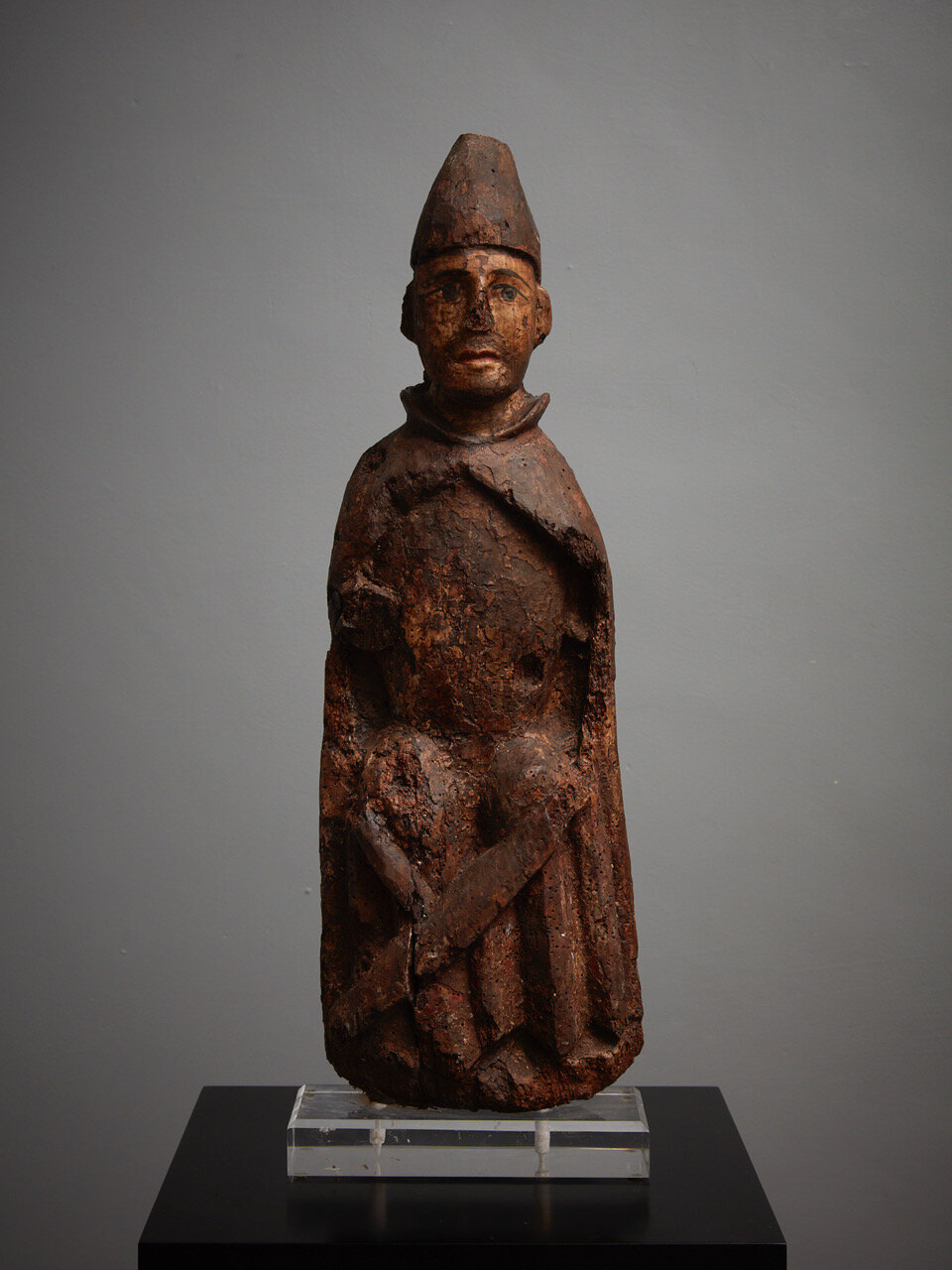
Romanesque Statue
Late 13th - early 14th century, Iberian (probably Pyrennes)
590 x 200 x 95mm
Provenance: Private collection, Madrid, Spain.
A wooden sculpture of a seated male figure, wearing a conical hat, long robe, and cape. This is almost certainly a representation of Saint Peter as the first pope of the Catholic Church. An inverted ‘T’ shaped object rests diagonally against his legs, symbolising Saint Peter’s martyrdom – he was crucified upside down. These images of Saint Peter as Pope were common until the 14th century. The sculpture is very distressed; both arms and feet are missing, as is most of the nose. Traces of polychromy are visible in the dark patina, and the painting of the eyes is still distinct.
The Romanesque world extended roughly from about the late 10th century to around 1200. In Spain, it flourished in the northern half of the country and is notable by its absence in the south, which, despite advances made by the Christian kingdoms of the north, was still firmly held by Muslim al-Andalus. The aesthetic of the piece is characteristic of Romanesque culture – heavily stylised, rigid, and imposing. Its relative simplicity and lack of refinement in the detailing suggest that it is a popular, folk art version of the Romanesque high art made for Cathedrals and noble homes during this period.
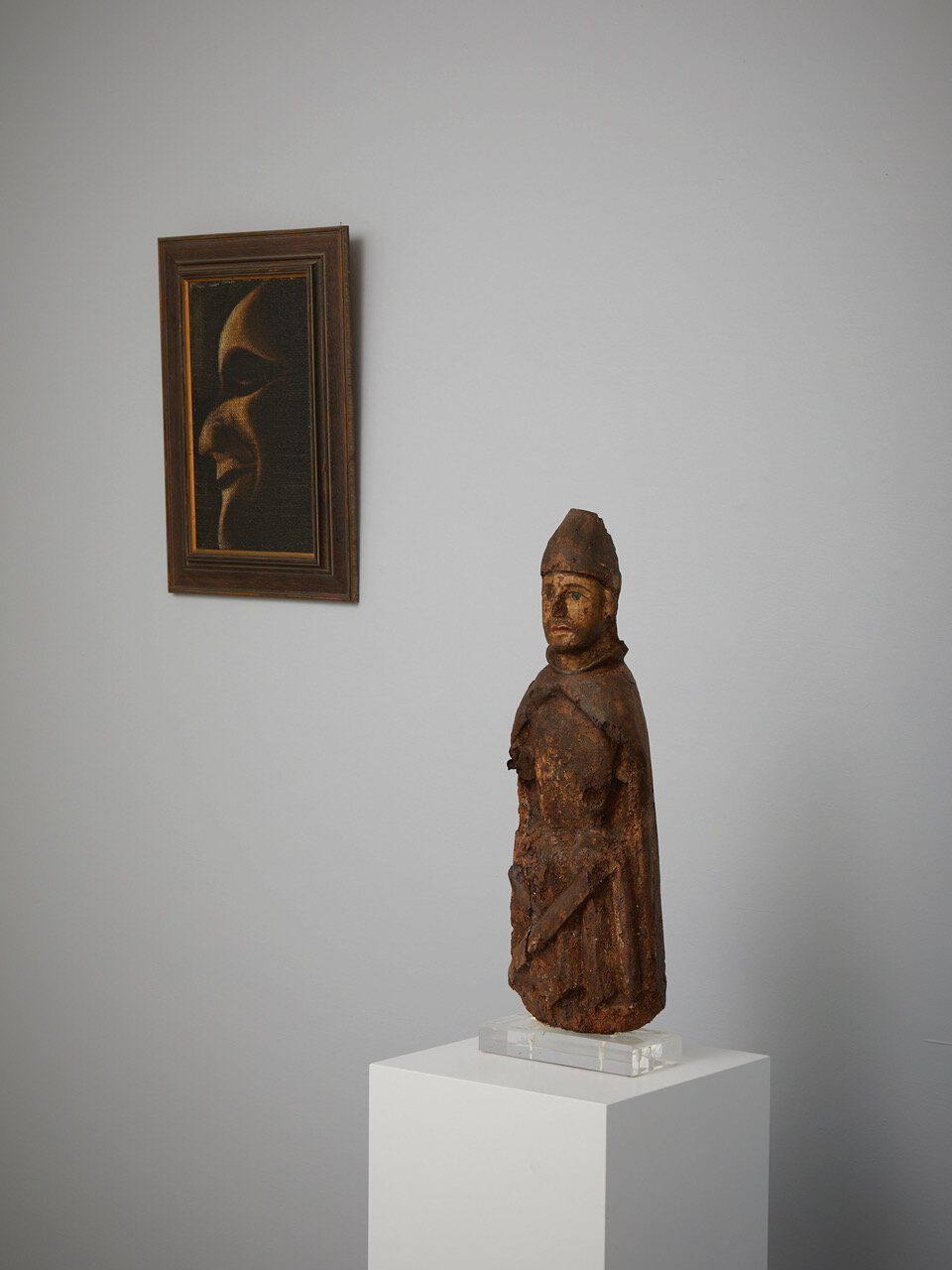
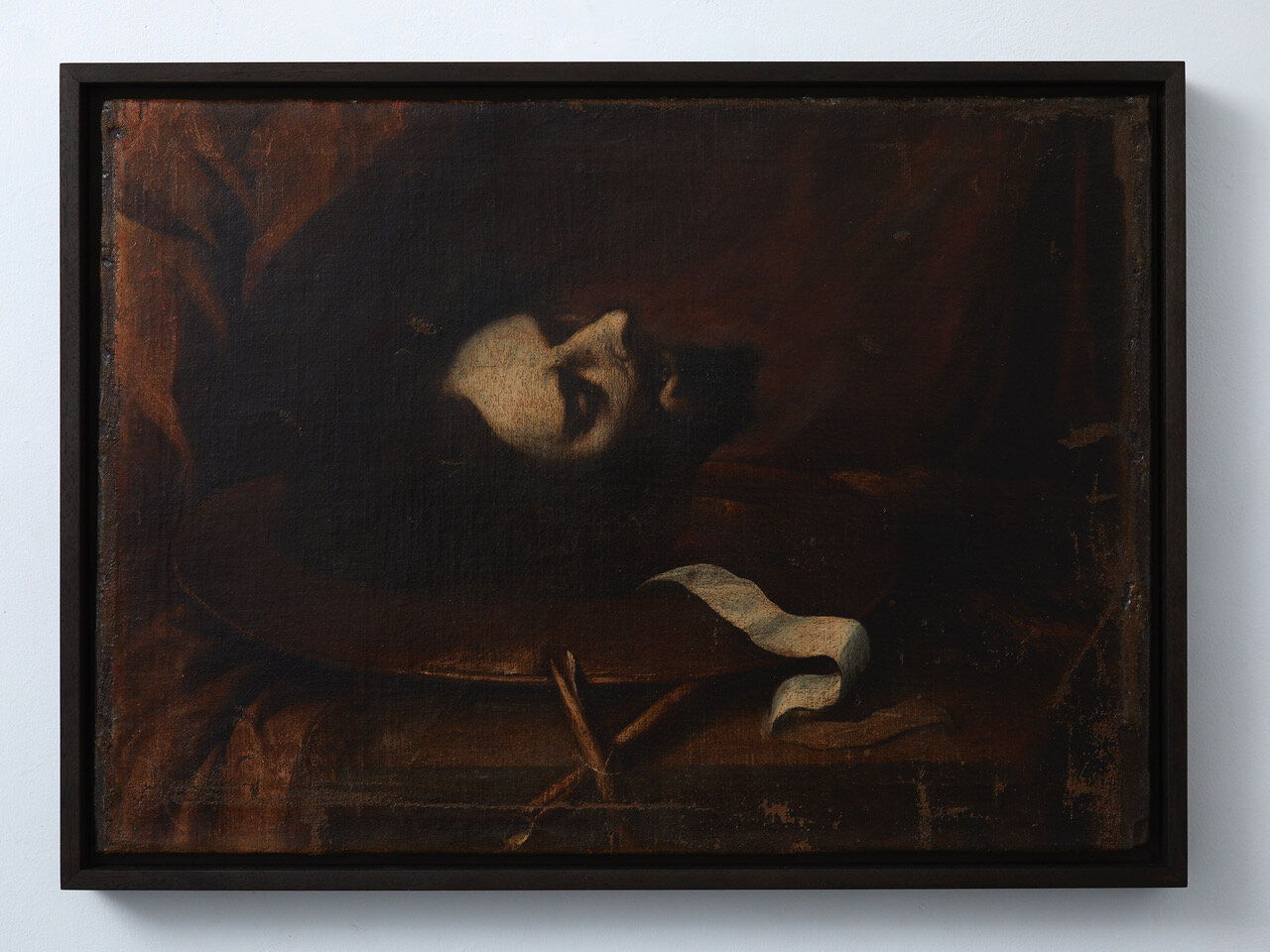
The Head of John the Baptist
17th century, Sevillian school (possibly from the workshop of Sebastian de Llanos Valdés)
555 x 770mm
Provenance: Private collection, Madrid, Spain.
Oil on canvas of the severed head of John the Baptist, on a metal platter (pewter or copper). Tucked underneath the platter is a thin, crude wooden cross, which is almost always carried by John the Baptist in artistic depictions, and draped over the edge of the plate is a ribbon-like scroll. The severed head is painted in stark pallid tones, which contrast with the deep shadows.
Paintings of the severed heads of martyr saints form part of an artistic tradition that can be traced back to Spanish sculpture from the last quarter of the 16th century. The majority of the painted treatments of this subject were produced by a number of leading Spanish (and especially Sevillian) artists. The earliest known painting of a severed martyr's head is a work by Jusepe de Ribera (1591-1652) of around 1636, depicting The Head of Saint John the Baptist, today in the Real Academia de San Fernando, Madrid. In Seville, Francisco de Zurbarán (1598-1664) painted a set of severed heads of saints for the main altar of the Iglesia de los Mercedarios Descalzos, and in around 1650 Herrera el Viejo (1576-1656) painted two severed heads of saints, one of which is today in the Prado Museum. The majority of unsigned paintings of saintly severed heads from this period were once attributed to Juan de Valdés Leal, but subsequent scholarship concluded that they are most likely to be the work of a student of Herrera el Viejo called Sebastian de Llanos Valdés (c. 1605–1677). It appears that he carved out something of a niche for himself painting severed heads for private patrons.
Valdés' oeuvre consists almost entirely of religious imagery, and his style reflects the artistic traditions of his time, including the deep chiaroscuro used by the ‘Spanish Caravaggio’, Zurbarán. Within Valdés' artistic production lies a significant group of severed heads of martyr saints, most of which appear to date from the 1660s and 1670s. Valdés paints with intense realism, conveying the full physical horror of martyrdom — the decapitated heads displaying a palpable sense of rigor mortis and the pewter dishes splattered with blood from the severed necks. These qualities are very evident in this work, with the lividity of the facial flesh and the grotesquely gaping jaw. It is possible that this painting comes at least from the workshop of Sebastián de Llanos Valdés, if not actually from his own hand.
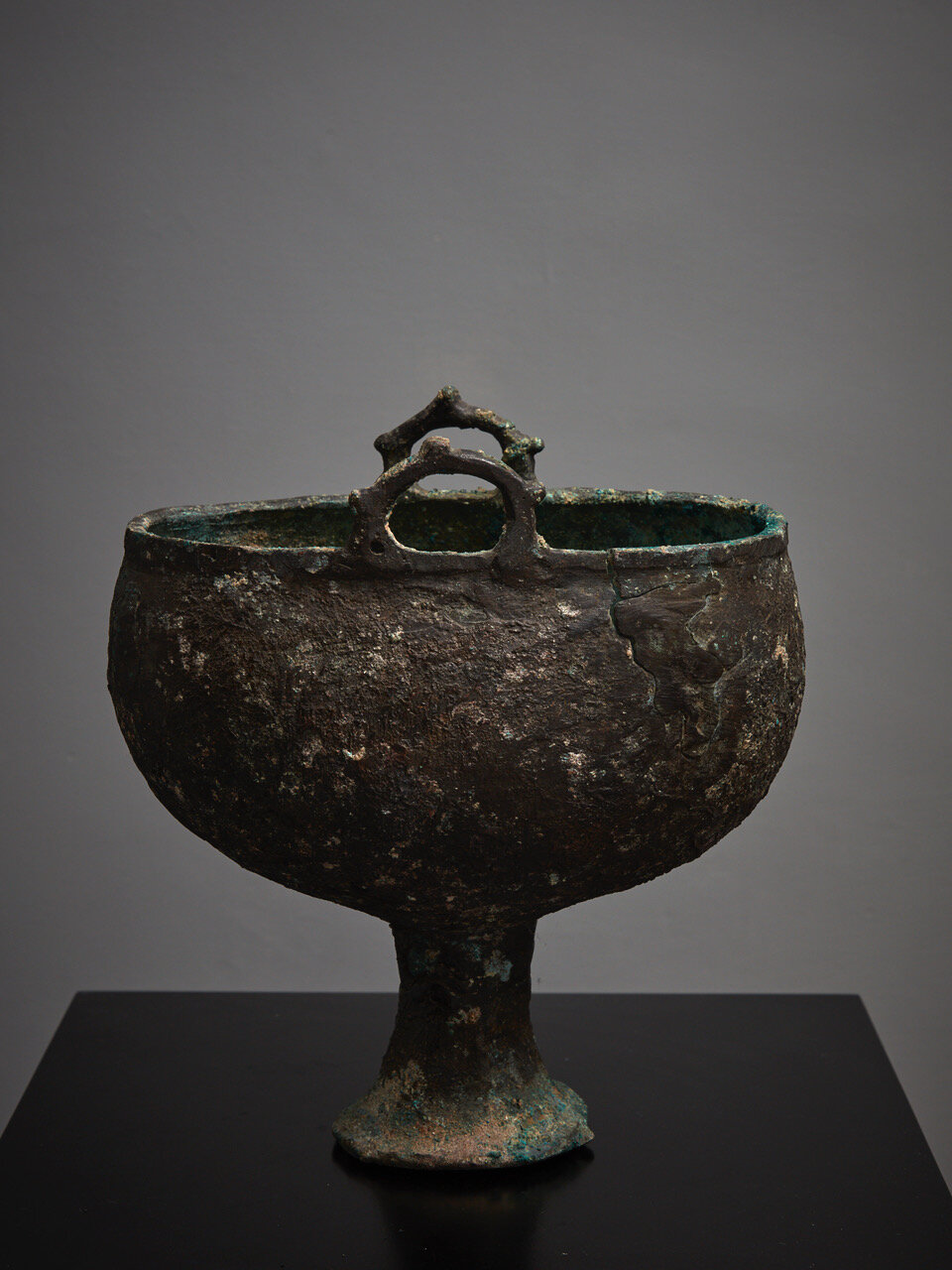
Scytho-Sarmatian Bronze Vessel
Late Scythian, 3rd - 2nd century BC, Scytho-Sarmatian, Crimea
250 x 210 x 140mm
Provenance: Private collection, South Germany; Exhibition Bonn (2013) p. 259 cat III.10 (Tavrida Central Museum Simferopol, Inv. D-17765 HB).
Scytho-Sarmatian bronze vessel with high foot, conical base, and an oval basin with two handles, each with three protuberances. The surface has a blackish-green patina, and there is a crack beside one handle and a small hole in the base, which shows some evidence of an old repair. The Scythians and Sarmatians were two closely related peoples who populated the Eurasian steppe from roughly the 9th century BC to the 3rd century AD. Both lived in nomadic pastoral societies and were feared in antiquity as formidable horse-back warriors — Scythian warrior women are speculated to have been the historical inspiration for the Amazons of Greek mythology. They are known for producing masterful metalwork, particularly in bronze and gold. Archaeological and documentary evidence also shows that Scytho-Sarmatian peoples adorned themselves in tattoos, enjoyed smoking hemp, drinking wine and fermented mares’ milk.
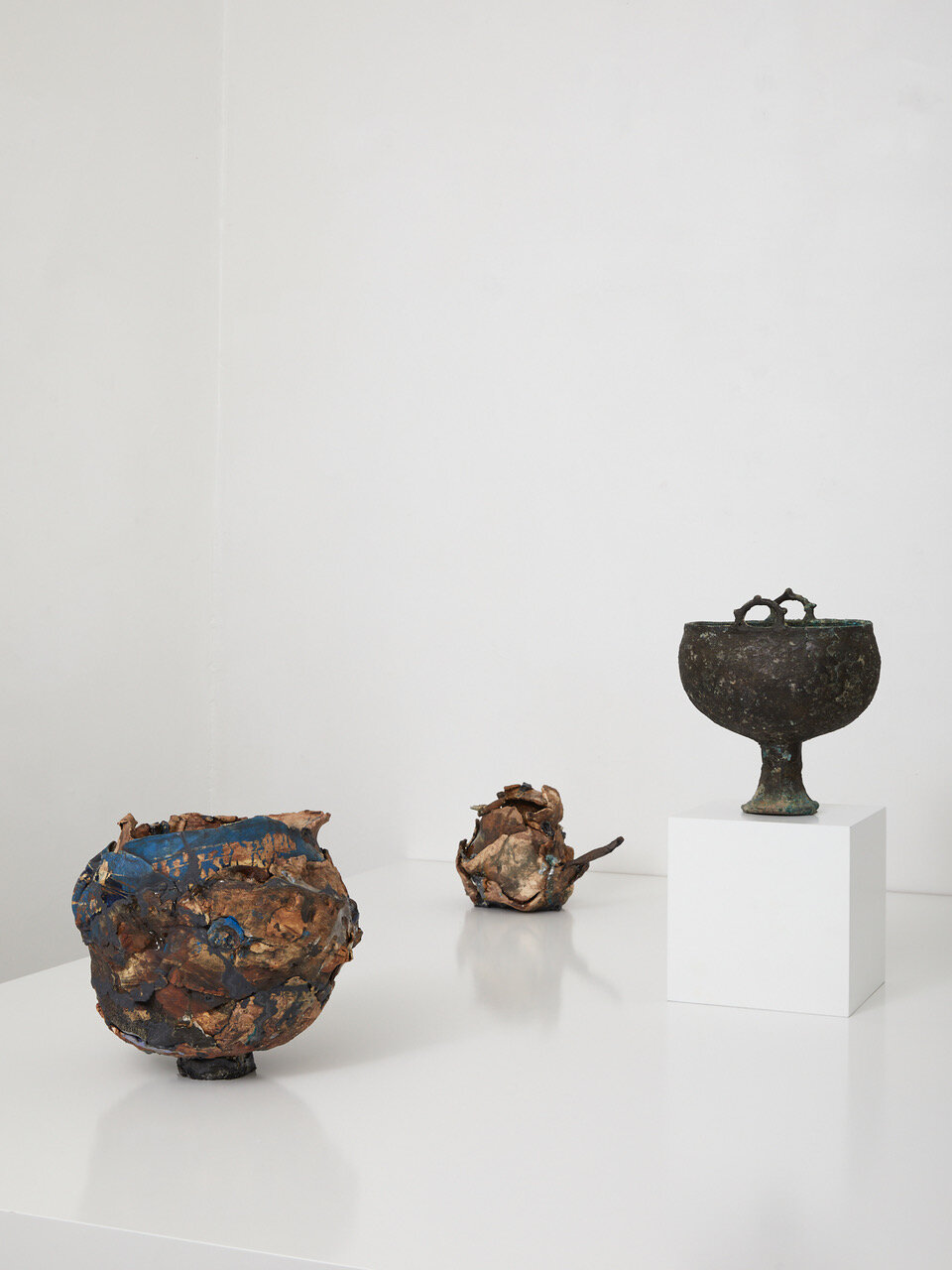
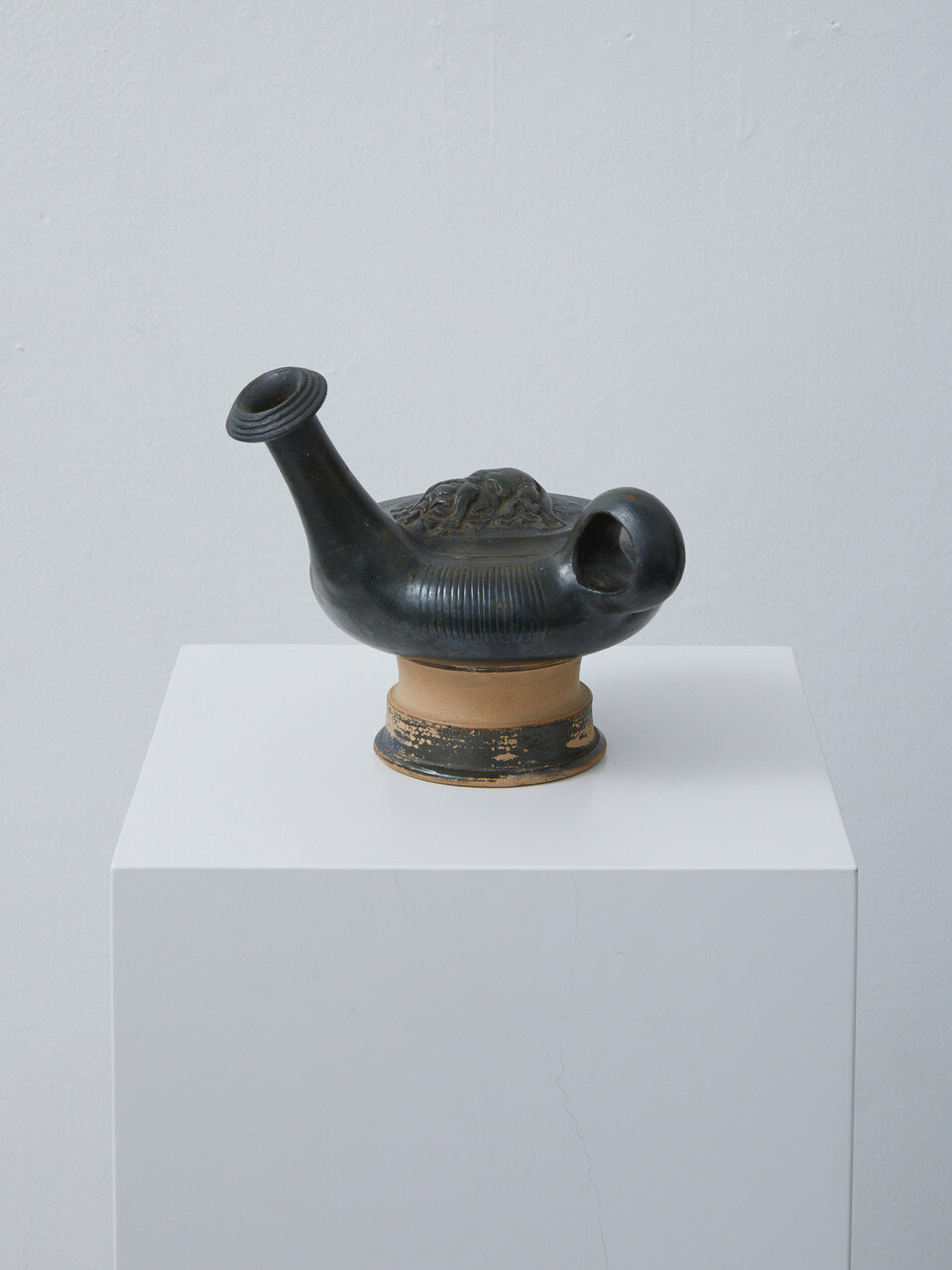
Campanian Black-Glazed Guttus
Hellenistic period, 2nd half of the 4th century BC, Western Greek, Campania
135 x 150 x 115mm
Provenance: L.J. collection, Netherlands; Private collection, USA.
Campanian black-glazed guttus made from toned clay with ribbed body and ring handle. Decorated with moulded medallion of a satyr head with goat horns. Satyrs were part of the Thiasus, or entourage of the god Dionysus. The surface is partially rubbed, but the guttus is otherwise intact. Western Greek is a term, which refers to objects produced in Greek colonies in Southern Italy. These small vessels were used to slowly pour liquid in drops — probably in the context of religious rituals such as sacrifices.
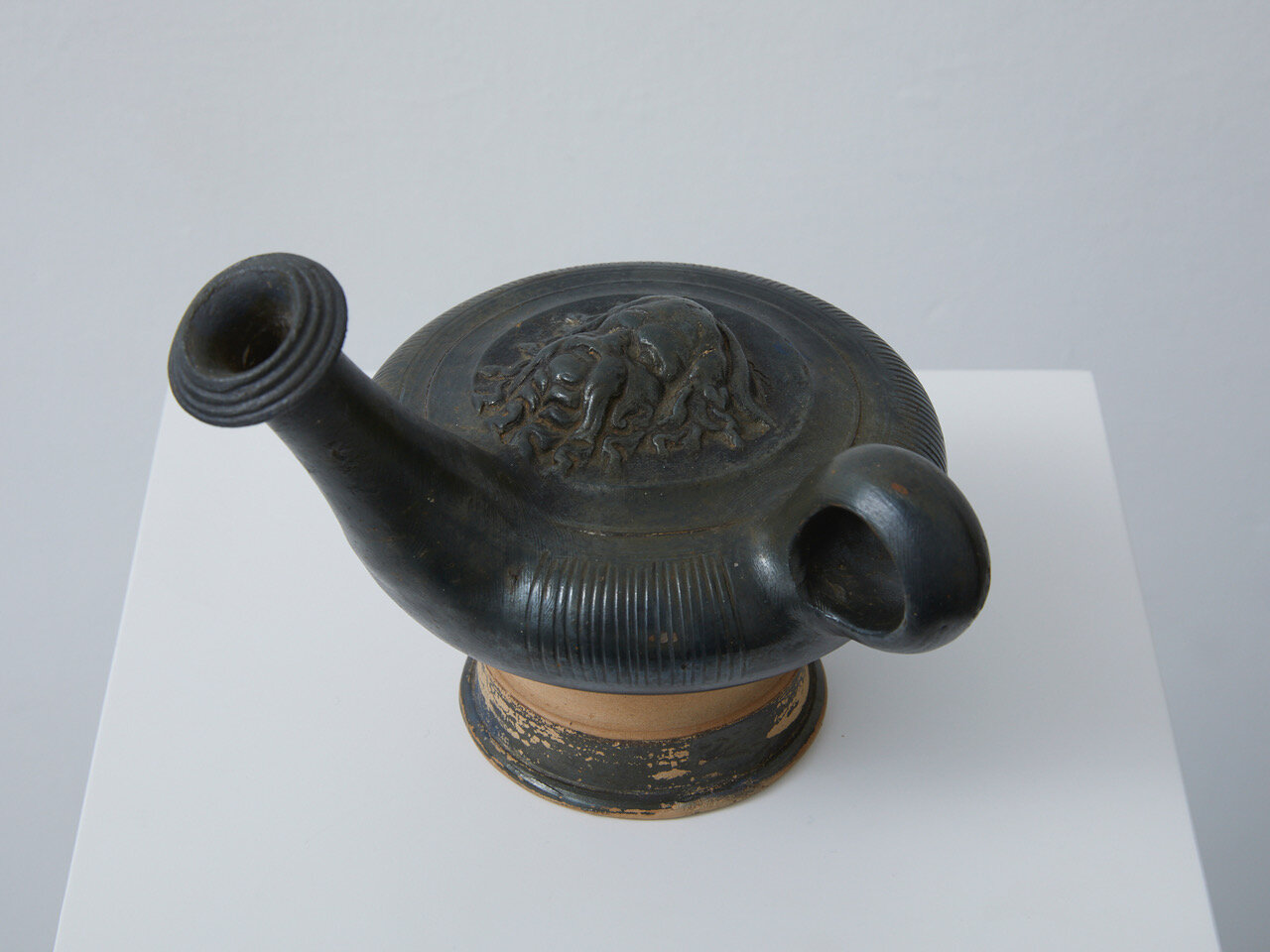
Campanian Black-Glazed Guttus
Hellenistic period, 2nd half of the 4th century BC, Western Greek, Campania
135 x 150 x 115mm
Provenance: L.J. collection, Netherlands; Private collection, USA.
Campanian black-glazed guttus made from toned clay with ribbed body and ring handle. Decorated with moulded medallion of a satyr head with goat horns. Satyrs were part of the Thiasus, or entourage of the god Dionysus. The surface is partially rubbed, but the guttus is otherwise intact. Western Greek is a term, which refers to objects produced in Greek colonies in Southern Italy. These small vessels were used to slowly pour liquid in drops — probably in the context of religious rituals such as sacrifices.
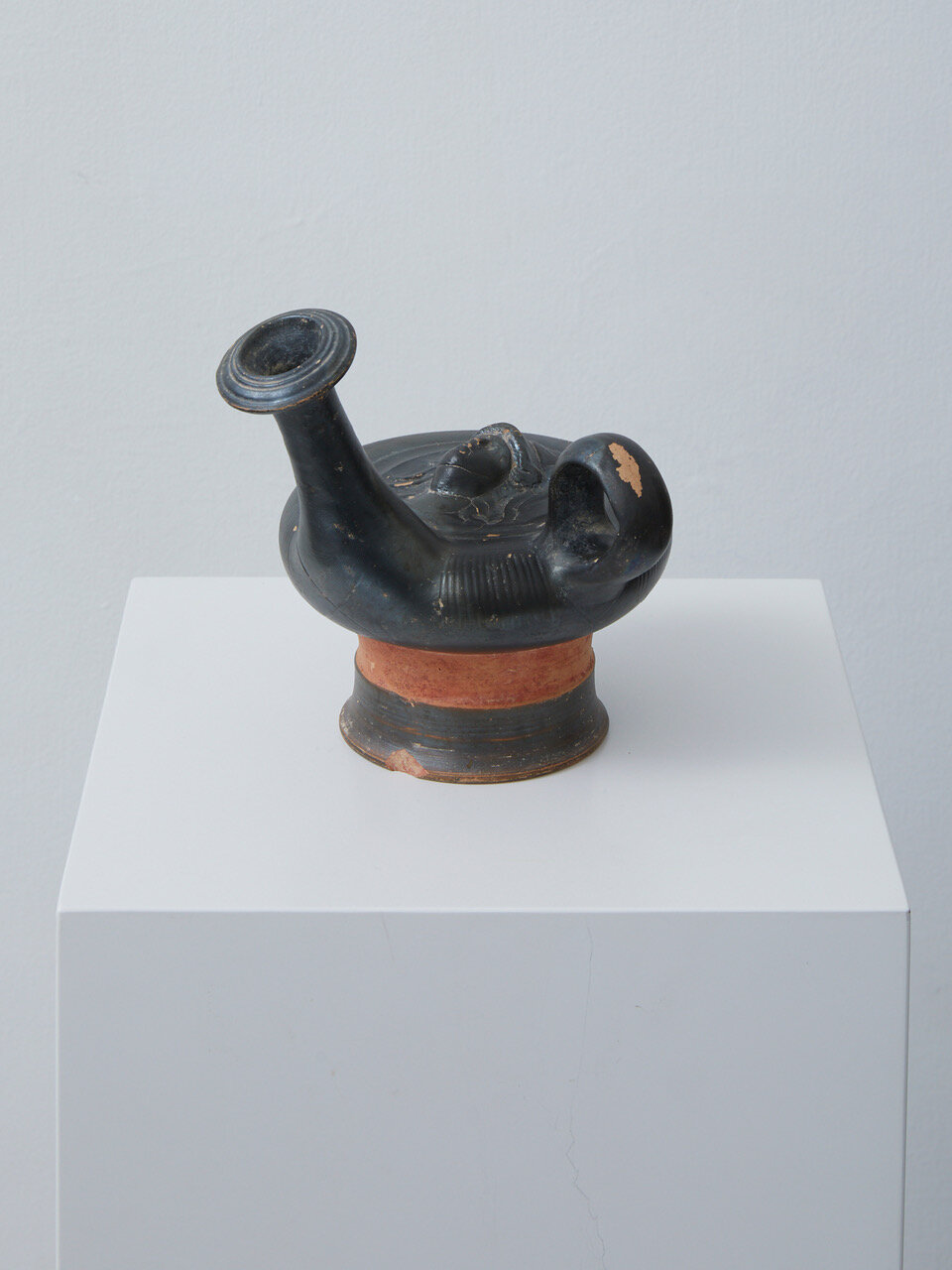
Apulian Black-Glazed Guttus
Hellenistic period, 2nd half of the 4th century BC, Western Greek, Apulia
130 x 140 x 155mm
Provenance: Private collection, West Germany.
Apulian black-glazed guttus made from toned clay with ribbed body and ring handle. Decorated with a plastically moulded frontal bust of Pallas Athena, the Olympian goddess of wisdom and war, amongst other things. There are two small chips on the foot of the vessel, but it is otherwise intact. Western Greek is a term which refers to objects produced in Greek colonies in Southern Italy. These small vessels were used to slowly pour liquid in drops — probably in the context of religious rituals such as sacrifices.
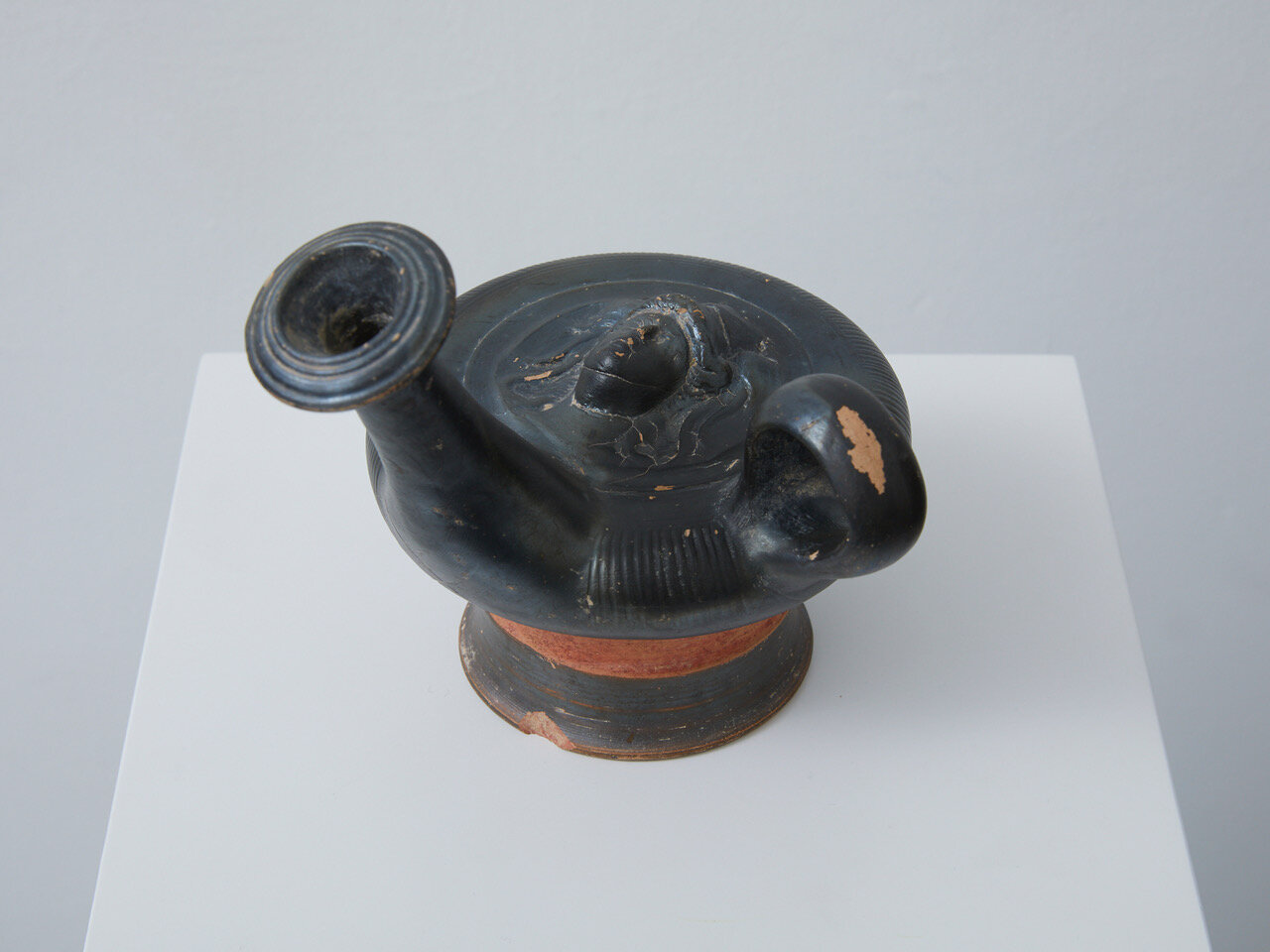
Apulian Black-Glazed Guttus
Hellenistic period, 2nd half of the 4th century BC, Western Greek, Apulia
130 x 140 x 155mm
Provenance: Private collection, West Germany.
Apulian black-glazed guttus made from toned clay with ribbed body and ring handle. Decorated with a plastically moulded frontal bust of Pallas Athena, the Olympian goddess of wisdom and war, amongst other things. There are two small chips on the foot of the vessel, but it is otherwise intact. Western Greek is a term which refers to objects produced in Greek colonies in Southern Italy. These small vessels were used to slowly pour liquid in drops — probably in the context of religious rituals such as sacrifices.
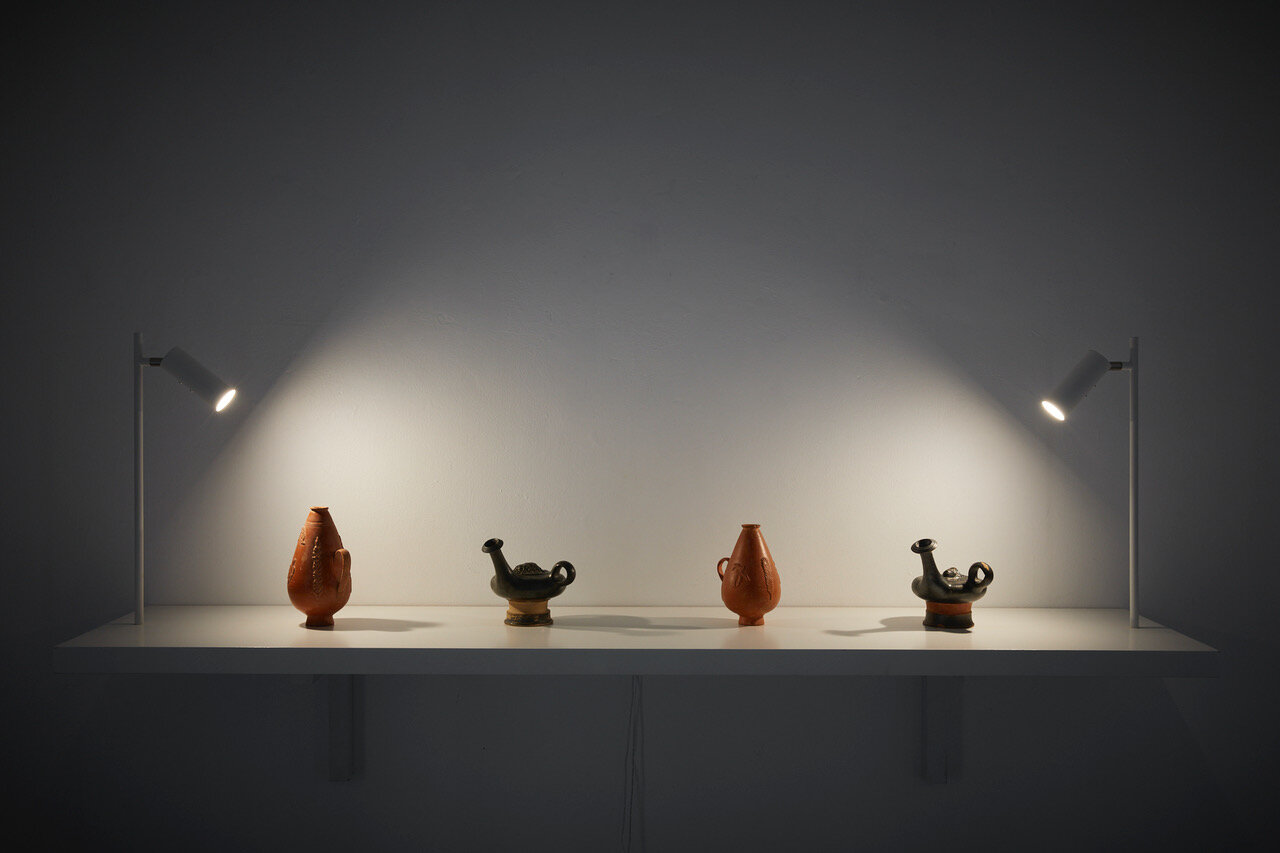
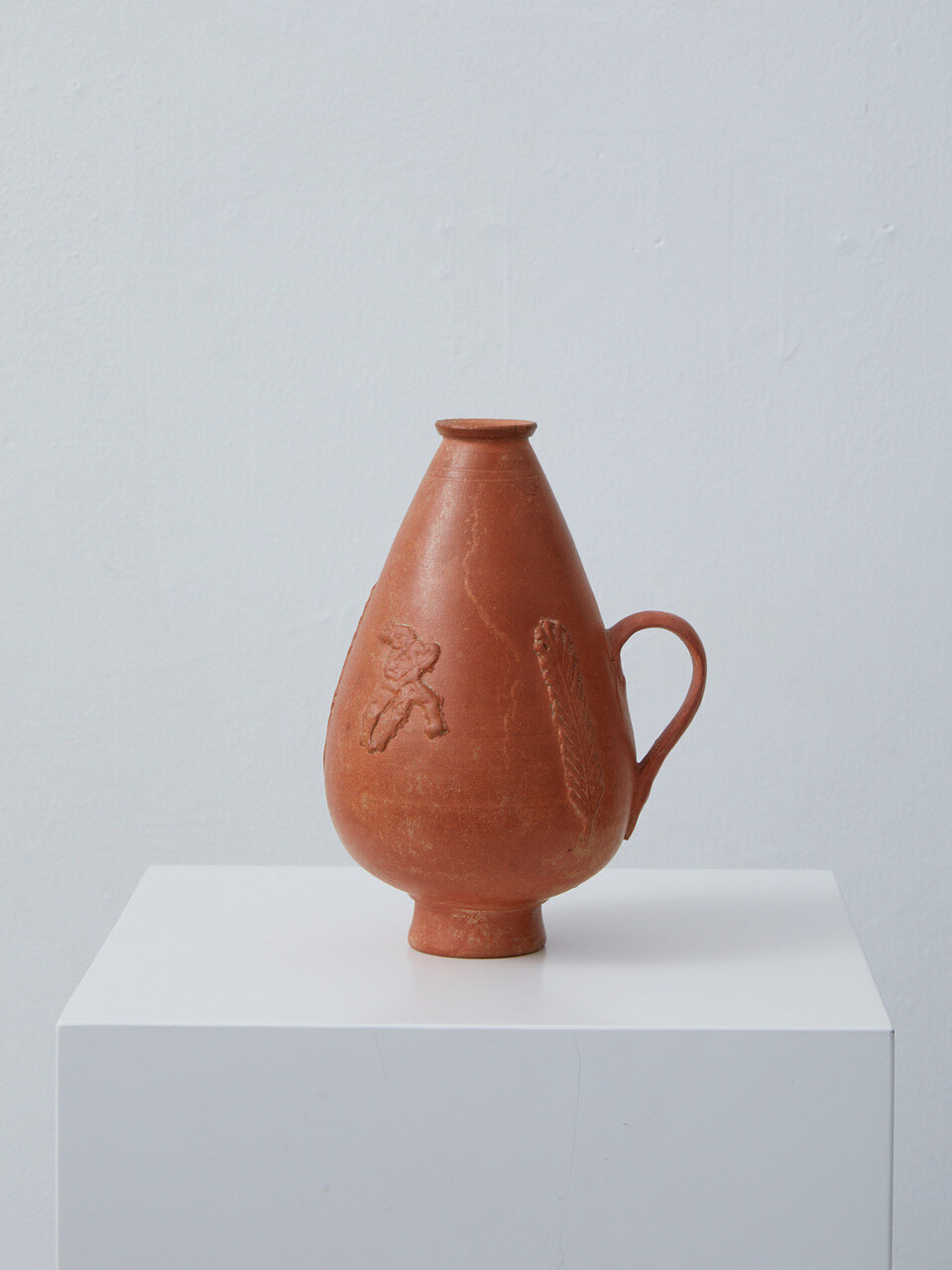
Roman Red-Slip Terracotta Jug (1)
Late Imperial Period, 3rd century AD, North African (Tunisia)
150 x 101 x 90mm
Provenance: Private collection, Munich, Germany.
Roman narrow-mouthed piriform vessel distinctive of the North African pottery industry (now modern day Tunisia), with handle and a small foot. Applied relief decoration on the body consisting of two vertical dividing palm branches between which are two figures of Faunus (Roman equivalent of Pan) wrestling with an animal. The handle is restored, but the vessel is otherwise intact.
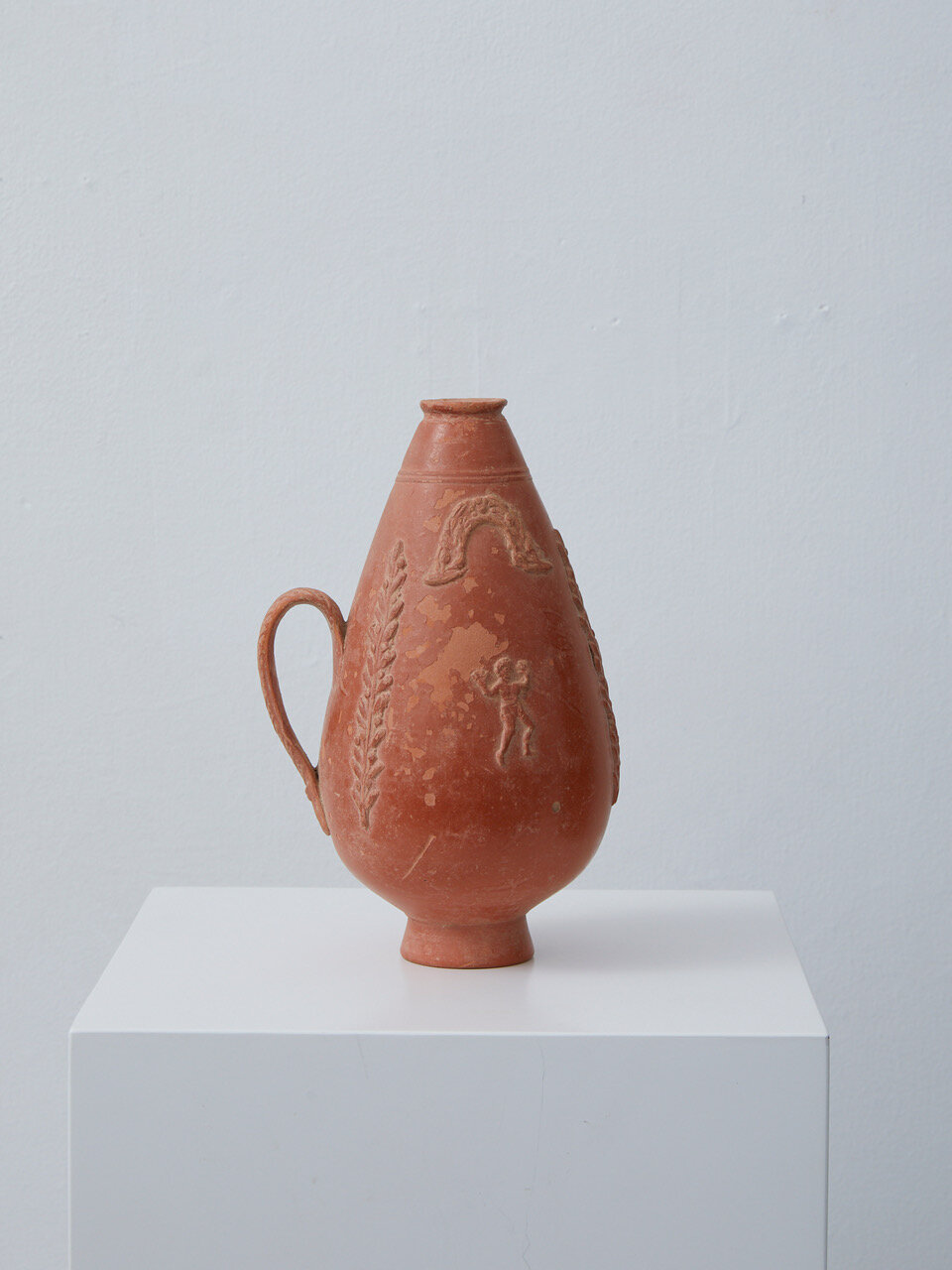
Roman Red-Slip Terracotta Jug (2)
Late Imperial Period, 3rd century AD, North African (Tunisia)
180 x 120 x 100mm
Provenance: Private collection, Munich, Germany.
Roman narrow-mouthed piriform vessel distinctive of the North African pottery industry (now modern day Tunisia), with handle and a small foot. Applied relief decoration on the body consisting of three vertical dividing laurel branches with an eagle and a dancing male figure in between, and an arched floral garland above each figure.
The Virgin of the Annunciation
15th century, Bohemia (Czech Republic)
430 x 260 x 150mm
Provenance: Private collection, Madrid, Spain.
A very fine carved alabaster statue of The Virgin of the Annunciation, surprised in her spiritual meditations by the apparition of the archangel Gabriel, announcing her conception of the Christ child. This statuette’s sensitively carved features and slight smile, elongated proportions, and graceful draperies show stylistic analogies to courtly art in Paris. In fact, this is a very direct copy of the early 14th century French limestone Virgin of the Annunciation (1300 - 1310, 424 x 296 x 188mm) now housed in the Metropolitan Museum of Art, New York.
A comparable piece was catalogued by the French Haute Epoque expert and art consultant, Laurence Fligny. Fligny designates the piece as Central European, Bohemian or Pomeranean, c. 1420/1430. Both of these pieces would appear to belong to the same period of artistic creativity in early 15th century Bohemia.
King Charles IV of Bohemia (c.1316 - 1378) was determined to rebuild his capital city Prague in the image of Paris and Rome, and to turn it into a hub of learning, spirituality, and the arts. A new generation of Bohemian artists drew specifically on international prototypes (such as the Paris Virgin) to embellish Charles’ building projects. This artistic activity continued well after Charles’ death in 1378. Amongst the many iconic religious images produced around 1400 were a series of paintings and sculptures of ‘Miraculous Madonna’s’, many of whom inspired intense cult followings. These images expressed a distinct aesthetic, known as ‘The Beautiful Style’, which depicted Mary as a courtly medieval princess. These so-called ‘Beautiful Madonna’s’ are characterised by an affected elegance; typically, cascading folds of drapery cover a demure female figure poised in an exaggerated ‘S’ stance. The facial features are similarly distinctive; a girlish face with a high smooth forehead, delicate chin and lips, and almond eyes. The necks are elongated and curved, the shoulders narrow, and the fingers of the hands long and tapering. All of these features are very evident in this sculpture, dating it to the early 1400s. Early alabaster figures almost always show traces of polychromy and/or gilding — or glazing intended to make them resemble bronze, since the most admired and technically impressive statues from antiquity were cast in this material. The patination on this piece is suggestive of this kind of ‘bronze’ glazing.
Orthodox Icon of Christ the Pantocrator
Mid-late 18th century, Western Russian (probably St Petersburg)
350 x 265 x 65mm
Provenance: Private family collection of a Russian emigre, Rhode Island, USA.
An Orthodox icon painted in oil on a wooden panel and covered with a heavy, carved, repoussé silver covering (called an oklad). The subject is Christ as the Pantocrator, or teacher of men. This is very common theme in Orthodox iconography, but this particular icon shows Christ in a more sophisticated three-quarter view, as opposed to a frontal view which is the more typical presentation. Traditionally icons were painted in egg tempera and the figuration was highly stylised, but in the mid 18th century the influence of Western portrait painting produced a new type of icon, painted in oils and offering more naturalistic and humanised images. The silver coverings or oklads were commissioned by families for icons which had proven effective in focusing prayers and producing results. In this way the icon was protected (from dirt and smoke from incense and icon lamps) and also honoured.
Bronze Enkolpion
Middle Byzantine Period, 10th - 12th century AD, Byzantium (Eastern Roman Empire)
60 x 40 x 5mm
Provenance: Private collection, Munich, Germany.
Half of a bronze enkolpion (medallion) with engraved figure standing in the attitude of Orans (a posture of prayer and supplication) and wearing a long robe, with nimbus and cross, and two stars flanking each hand of the figure. Green patina, minor damages at the hinges. These cruciform reliquaries were worn around the neck and many were produced in such a way as to hold a secondary relic (such as a piece of a saint’s clothing or hair, or a piece of the True Cross). They are believed to have substituted the use of bullae (pendants containing amulets against incantations), which were worn by Romans prior to Christian conversion. In this way, it can be regarded as an object, which bridges the Graeco-Roman and Christian worlds presented in Provenance II.
Madonna and Child (Sedes Sapientiae)
12th - early 13th century, Northern Europe (probably Spain)
580 x 210 x 170mm
Provenance: Private collection, Spain.
A softwood Madonna and Child statue, heavily distressed but essentially intact, with traces of polychromy (probably egg tempera). Both figures are rendered in the typical Romanesque style; the composition is formal and frontal, with the Christ child sitting on the Madonna’s left knee. She holds a pomegranate with her right hand, symbolic of the blood and resurrection of Christ, and the Christ’s right arm is raised, his hand making the gesture of benediction (blessing). The Madonna’s face is massive and mask-like, as is that of the Christ, emphasising that they are eternal presences rather than ordinary human beings. As in Byzantine iconography — from which the Romanesque style is derived — the primitive, highly stylised rendering of the Madonna and Child serve to accentuate their sheer spiritual power.
The figure of the Virgin and Child enthroned was a hugely popular iconographical theme particularly during the Middle-Ages. Throughout the 12th century, the Virgin Mary appears in churches all over Europe (France, Germany, Belgium, Scandanavia, England, Italy and Northern Spain) sitting majestically, her body forming Christ’s throne. This kind of presentation is called Sedes Sapientiae, meaning The Throne of Wisdom.
Virgin del Populo
18th century, Continental Europe (most likely Southern Spain or Italy)
160 x 130mm
Provenance: Private collection, Madrid, Spain.
Catholic icon of the Virgin Mary holding the Christ Child, painted in oils on a heavy gauge copper sheet, with a thick application of gilding in the background. The young Jesus is making a gesture of benediction (blessing). This is one of many copies made of an original icon supposedly painted by Saint Luke (who, according to Catholic tradition, was the first icon painter). St Luke’s original version is reputed to have miraculously ended a plague epidemic in Rome in 1231, and thereafter was known as the Sales Populi Romani (The Salvation of the Roman People). The Virgin del Populo became one of the most popular Marian icons through the centuries, attracting many pilgrims to the church of Santa Maria del Populo in Rome, where it is still housed today.
Copies of both Catholic and Orthodox icons — even the smallest and crudest — are felt by the faithful to share something of the miraculous qualities of the original. Hence there was a proliferation of large and small copies of The Virgin del Populo throughout the Catholic world, stretching as far as Eastern and Northern Europe, and the New World. The Virgin del Populo was specially venerated in Italy and Southern Spain, particularly Seville and Cadiz. The sheer popularity of this image makes it hard to determine the origin of this particular version: however, given its provenance, it is most likely to be Spanish.
Saint Catherine of Siena in Meditation
12th - early 13th century, Northern Europe (probably Spain)
180 x 140mm
Provenance: Private collection, Madrid, Spain
Catholic icon painted in oils on copper sheet. It depicts the saint Catherine deep in meditation, wearing her characteristic Dominican robes. She holds her usual attributes, a stem of lilies and a crucifix, and is shown before an altar or table upon which a bible lies open. Saint Catherine of Siena was a Dominican tertiary and mystic who lived in Italy in the 1300s. She was known for her holiness, asceticism, and spiritual visions, and was said to have received stigmata. She was also a reformer and political activist, and was influential in both the religious and political affairs of the church. Her image was popular as the subject of small paintings like this, intended for use in the homes of the Catholic faithful.
Drawing by François Boucher
1703-1770, Paris
275 x 370mm
Provenance: Private collection, Spain.
An academic drawing in sanguine chalk depicting a male nude. François Boucher (c. 1703–1770) was a French Rococo painter, engraver, and designer, who epitomised the frivolity, elegance, and extravagance of the French court in the 18th century. His career was hugely successful and he received many honours, becoming Director of the Gobelins factory in 1755 and Director of the Academy and King's Painter in 1765. He was the favourite artist of Louis XV’s most famous mistress, Madame de Pompadour, to whom he gave lessons, and whose portrait he painted several times.
Boucher was also a virtuoso draftsman. Drawings played a large role in the preparation of paintings and as designs for printmakers, as well as being created as finished works of art for the growing market of collectors. For his major canvases, Boucher followed standard studio practices of the time, working out the overall composition and then making chalk studies for individual figures or groups of figures. He was an incredibly productive artist, making thousands of drawings both as sketches and finished works in chalk, ink, and pastels. One of the most notable things about Boucher's superb draughtsmanship is his energetic, economical mark-making. Grace, beauty and power combine with a striking inner force. Such was his popularity that a great number of printmakers found it lucrative to reproduce his paintings and drawings; some 1,500 prints after Boucher are known today.
Drawing by François Boucher
1703-1770, Paris
275 x 370mm
Christ Child with Instruments of the Passion
17th - 18th century, Iberian Peninsula School
620 x 495mm
Provenance: Private collection, Madrid, Spain.
Oil on canvas depicting the young Christ child walking alone in a darkening landscape, wearing a red robe and a crown of thorns, and carrying a wooden cross. He looks upwards to Heaven, and emanating from his head are faint rays in the shape of the Tres Potencias (symbolising the three Powers of the Lord: authority, ability, and strength). This is an allegorical painting, most likely commissioned for private devotion, and intended to inspire sympathy and pity for Christ’s suffering. This type of painting seems to have been very popular in the Iberian Peninsula and the Spanish and Portuguese colonies in the 18th and 19th centuries. There are several set pieces of this nature in popular Catholic art which relate to the idea of Christ’s martyrdom being predestined, and which depict Christ as a small child in the presence of symbols of the Passion. One such set piece depicts him sleeping next to a skull (the skull of Adam, often appearing in art at the foot of the cross); another depicts him pricking his finger or foot with a thorn; and another depicts him carrying his cross and sometimes the crown of thorns. This particular painting falls into the latter category of set piece. It is very finely painted, and the Christ child has been rendered with a softness and emotionality which juxtaposes his innocence with the harshness of his fate.
Romanesque Statue
Late 13th - early 14th century, Iberian (probably Pyrennes)
590 x 200 x 95mm
Provenance: Private collection, Madrid, Spain.
A wooden sculpture of a seated male figure, wearing a conical hat, long robe, and cape. This is almost certainly a representation of Saint Peter as the first pope of the Catholic Church. An inverted ‘T’ shaped object rests diagonally against his legs, symbolising Saint Peter’s martyrdom – he was crucified upside down. These images of Saint Peter as Pope were common until the 14th century. The sculpture is very distressed; both arms and feet are missing, as is most of the nose. Traces of polychromy are visible in the dark patina, and the painting of the eyes is still distinct.
The Romanesque world extended roughly from about the late 10th century to around 1200. In Spain, it flourished in the northern half of the country and is notable by its absence in the south, which, despite advances made by the Christian kingdoms of the north, was still firmly held by Muslim al-Andalus. The aesthetic of the piece is characteristic of Romanesque culture – heavily stylised, rigid, and imposing. Its relative simplicity and lack of refinement in the detailing suggest that it is a popular, folk art version of the Romanesque high art made for Cathedrals and noble homes during this period.
The Head of John the Baptist
17th century, Sevillian school (possibly from the workshop of Sebastian de Llanos Valdés)
555 x 770mm
Provenance: Private collection, Madrid, Spain.
Oil on canvas of the severed head of John the Baptist, on a metal platter (pewter or copper). Tucked underneath the platter is a thin, crude wooden cross, which is almost always carried by John the Baptist in artistic depictions, and draped over the edge of the plate is a ribbon-like scroll. The severed head is painted in stark pallid tones, which contrast with the deep shadows.
Paintings of the severed heads of martyr saints form part of an artistic tradition that can be traced back to Spanish sculpture from the last quarter of the 16th century. The majority of the painted treatments of this subject were produced by a number of leading Spanish (and especially Sevillian) artists. The earliest known painting of a severed martyr's head is a work by Jusepe de Ribera (1591-1652) of around 1636, depicting The Head of Saint John the Baptist, today in the Real Academia de San Fernando, Madrid. In Seville, Francisco de Zurbarán (1598-1664) painted a set of severed heads of saints for the main altar of the Iglesia de los Mercedarios Descalzos, and in around 1650 Herrera el Viejo (1576-1656) painted two severed heads of saints, one of which is today in the Prado Museum. The majority of unsigned paintings of saintly severed heads from this period were once attributed to Juan de Valdés Leal, but subsequent scholarship concluded that they are most likely to be the work of a student of Herrera el Viejo called Sebastian de Llanos Valdés (c. 1605–1677). It appears that he carved out something of a niche for himself painting severed heads for private patrons.
Valdés' oeuvre consists almost entirely of religious imagery, and his style reflects the artistic traditions of his time, including the deep chiaroscuro used by the ‘Spanish Caravaggio’, Zurbarán. Within Valdés' artistic production lies a significant group of severed heads of martyr saints, most of which appear to date from the 1660s and 1670s. Valdés paints with intense realism, conveying the full physical horror of martyrdom — the decapitated heads displaying a palpable sense of rigor mortis and the pewter dishes splattered with blood from the severed necks. These qualities are very evident in this work, with the lividity of the facial flesh and the grotesquely gaping jaw. It is possible that this painting comes at least from the workshop of Sebastián de Llanos Valdés, if not actually from his own hand.
Scytho-Sarmatian Bronze Vessel
Late Scythian, 3rd - 2nd century BC, Scytho-Sarmatian, Crimea
250 x 210 x 140mm
Provenance: Private collection, South Germany; Exhibition Bonn (2013) p. 259 cat III.10 (Tavrida Central Museum Simferopol, Inv. D-17765 HB).
Scytho-Sarmatian bronze vessel with high foot, conical base, and an oval basin with two handles, each with three protuberances. The surface has a blackish-green patina, and there is a crack beside one handle and a small hole in the base, which shows some evidence of an old repair. The Scythians and Sarmatians were two closely related peoples who populated the Eurasian steppe from roughly the 9th century BC to the 3rd century AD. Both lived in nomadic pastoral societies and were feared in antiquity as formidable horse-back warriors — Scythian warrior women are speculated to have been the historical inspiration for the Amazons of Greek mythology. They are known for producing masterful metalwork, particularly in bronze and gold. Archaeological and documentary evidence also shows that Scytho-Sarmatian peoples adorned themselves in tattoos, enjoyed smoking hemp, drinking wine and fermented mares’ milk.
Campanian Black-Glazed Guttus
Hellenistic period, 2nd half of the 4th century BC, Western Greek, Campania
135 x 150 x 115mm
Provenance: L.J. collection, Netherlands; Private collection, USA.
Campanian black-glazed guttus made from toned clay with ribbed body and ring handle. Decorated with moulded medallion of a satyr head with goat horns. Satyrs were part of the Thiasus, or entourage of the god Dionysus. The surface is partially rubbed, but the guttus is otherwise intact. Western Greek is a term, which refers to objects produced in Greek colonies in Southern Italy. These small vessels were used to slowly pour liquid in drops — probably in the context of religious rituals such as sacrifices.
Campanian Black-Glazed Guttus
Hellenistic period, 2nd half of the 4th century BC, Western Greek, Campania
135 x 150 x 115mm
Provenance: L.J. collection, Netherlands; Private collection, USA.
Campanian black-glazed guttus made from toned clay with ribbed body and ring handle. Decorated with moulded medallion of a satyr head with goat horns. Satyrs were part of the Thiasus, or entourage of the god Dionysus. The surface is partially rubbed, but the guttus is otherwise intact. Western Greek is a term, which refers to objects produced in Greek colonies in Southern Italy. These small vessels were used to slowly pour liquid in drops — probably in the context of religious rituals such as sacrifices.
Apulian Black-Glazed Guttus
Hellenistic period, 2nd half of the 4th century BC, Western Greek, Apulia
130 x 140 x 155mm
Provenance: Private collection, West Germany.
Apulian black-glazed guttus made from toned clay with ribbed body and ring handle. Decorated with a plastically moulded frontal bust of Pallas Athena, the Olympian goddess of wisdom and war, amongst other things. There are two small chips on the foot of the vessel, but it is otherwise intact. Western Greek is a term which refers to objects produced in Greek colonies in Southern Italy. These small vessels were used to slowly pour liquid in drops — probably in the context of religious rituals such as sacrifices.
Apulian Black-Glazed Guttus
Hellenistic period, 2nd half of the 4th century BC, Western Greek, Apulia
130 x 140 x 155mm
Provenance: Private collection, West Germany.
Apulian black-glazed guttus made from toned clay with ribbed body and ring handle. Decorated with a plastically moulded frontal bust of Pallas Athena, the Olympian goddess of wisdom and war, amongst other things. There are two small chips on the foot of the vessel, but it is otherwise intact. Western Greek is a term which refers to objects produced in Greek colonies in Southern Italy. These small vessels were used to slowly pour liquid in drops — probably in the context of religious rituals such as sacrifices.
Roman Red-Slip Terracotta Jug (1)
Late Imperial Period, 3rd century AD, North African (Tunisia)
150 x 101 x 90mm
Provenance: Private collection, Munich, Germany.
Roman narrow-mouthed piriform vessel distinctive of the North African pottery industry (now modern day Tunisia), with handle and a small foot. Applied relief decoration on the body consisting of two vertical dividing palm branches between which are two figures of Faunus (Roman equivalent of Pan) wrestling with an animal. The handle is restored, but the vessel is otherwise intact.
Roman Red-Slip Terracotta Jug (2)
Late Imperial Period, 3rd century AD, North African (Tunisia)
180 x 120 x 100mm
Provenance: Private collection, Munich, Germany.
Roman narrow-mouthed piriform vessel distinctive of the North African pottery industry (now modern day Tunisia), with handle and a small foot. Applied relief decoration on the body consisting of three vertical dividing laurel branches with an eagle and a dancing male figure in between, and an arched floral garland above each figure.





















